Resume Writers: 7 Things Job Seekers Should Know
Customers Interviewed by:
As a job seeker, your resume is one of the most important tools you have in your job search. But they’re so hard to write! Writing a resume that highlights your qualities and experiences is tricky if you’re not a writing expert. Because of that, many job seekers hire professional resume writers. But is that the best way to go?
Finding the best resume writing service can be tricky. Let me guide you through the process. You’ll learn where to find them and whether it’s worth hiring one.

How to choose the best resume writer service
When choosing the best resume writing services, consider the following factors:
1. Reputation: Look for resume writers with positive reviews and a strong reputation . This indicates their credibility and expertise in writing effective resumes.
2. Expertise: Make sure the writer has experience in your specific field or industry. A writer with expertise in your field will have a better understanding of the skills and qualifications that are valued in your industry. A targeted approach can increase your chances of securing interviews and landing your dream job.
3. Customization: Choose a service that offers personalized, tailored resumes instead of using templates. A personalized resume or CV will highlight your unique skills, experiences, and qualifications. That’s the key to standing out from other candidates.
4. Communication: Find a resume writer who listens to your needs and communicates throughout the process. The writer should take the time to understand your goals, accomplishments, and career history. They should also be open to feedback and willing to make revisions to ensure your satisfaction with the final product.
5. Price: Consider your budget, but remember that quality often comes at a higher cost. With resume writing services, you get what you pay for. Cheaper services may offer generic templates or lack the customization needed to effectively showcase your strengths.
The best resume writing services
If you’re looking for the best resume writing services, there are a few key places to consider. Check online platforms like LinkedIn, professional job boards, or reputable career coaching websites. Here are a few specific places you can look.
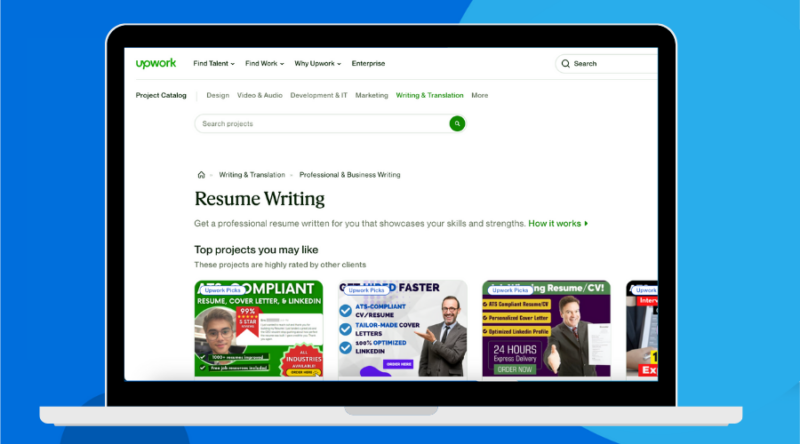
Upwork is a popular online platform that provides access to a global pool of experienced and certified professional resume writers. That makes it easier for you to find professional resume writing services. You can browse through thousands of reviews and ratings to find the best resume writer for your needs.
Price range: $30-500

Many professionals on LinkedIn offer resume writing services as part of their expertise. You can use keywords and filters to find someone who specializes in your industry or job level. One downside here is that many of these service listings don’t include prices. You have to request a proposal from each writer and then evaluate the prices. That extra step is a little bit of a hassle.
Price range: Prices vary depending on proposal.

TopStack Resume
TopStack Resume creates custom resumes tailored to individual job seekers. TopStack also offers cover letter writing and LinkedIn profile optimization services. However, this service isn’t cheap, especially if you want more than one resume or a more experienced writer working on your resume.
TopStack has four different packages that range in price from $139 to $649. A professional resume written by an experienced writer will cost at least $279.
If you want to have a resume tailored for each job you apply for (which most experts recommend), this can turn into an expensive service.
Price range: $139-649

ResumeSpice
ResumeSpice is another top resume writing service that provides personalized services. They have a team of experienced recruiters and writers who understand industry-specific requirements and best practices.
ResumeSpice packages range in price from $479 to $699, depending on services included. Like TopResume, ResumeSpice delivers one resume in each package and you only get two rounds of revisions, even in their highest-priced tier.
Price range: $479-699
Top free and paid resume writers and builders

Jobscan Resume Builder and Power Edit
Jobscan’s resume builder is completely free and very easy to use. It walks you through the entire process of building a resume from start to finish. And you can download your resume for free too!
After you write your resume, use Jobscan’s AI resume writer and editor, Power Edit , to optimize it. Power Edit shows you the skills you need to highlight on your resume and will even suggest phrases for each skill. It’s like having a professional writer at your fingertips!
With Jobscan , you can build, optimize, and tailor an unlimited amount of resumes. You can improve your chances of getting hired by creating resumes that effectively highlight your skills and experience.

Indeed offers a free resume builder that has a simple and intuitive interface. You can explore template options and easily customize your resume sections. Resumes created through Indeed’s resume builder can be downloaded, emailed, or printed.

Canva is a popular online design platform. It has a resume builder that provides visually appealing templates. Canva’s subscription-based resume builder allows you to customize resume layouts, fonts, and colors. You can use free and paid template options, each with different designs. Be mindful though that many of the templates Canva offers are not ATS-friendly.

LinkedIn allows you to download your public profile directly into a PDF resume. That makes it easy to use it in an application or email it to a recruiter. You can customize different resume sections, such as work history, education, and skills.
How much does a resume writer cost?
You can find professional resume writers at various price points. Career Sidekick researched the prices of 90 resume writers in the US. They found that the average cost of a writer is $527. However, they saw some as high as $3,000!
Find My Profession reviewed more than 100 professional resume writing services and found the range of prices to be from $99 to $2,597. According to their research, “The average cost for an entry-level resume is $220; mid-level is $422; executive-level is $1,252. The overall average cost for all professional resume services is $631.”
So you can expect to pay somewhere around $500-600 for a quality resume writer.
Is a professional resume writer service worth it?
Professional resume services can be extremely valuable. They have the expertise to create a resume that highlights your skills and experience effectively. They stay updated with current trends in the job market, ensuring that your resume stands out from the competition.
But it’s not always the perfect solution. Not everyone can afford it and you might go through some trial and error before you find the right writer.
What are the benefits of a professionally written resume ?
Professionally written resumes have numerous benefits.
- Hiring someone can save you time and effort: Writing an effective resume takes time and effort. By hiring a professional resume writer, you can save yourself the hassle and focus on other aspects of your job search, knowing that your resume is in capable hands.
- A professionally written resume might boost your confidence: Knowing that you have a well-crafted document that highlights your qualifications can give you the extra confidence needed during interviews and networking events.
- A resume writer can help you showcase your unique value proposition: A professional resume writer can help you identify and highlight your unique skills, experiences, and accomplishments that set you apart from other candidates.
- Expert resume writers know how to overcome employment gaps or career transitions: If you have gaps in your employment history or are changing careers , a professional resume writer can strategically address these challenges and present them in a positive light.
- A resume writer can give you objective feedback: Resume writers can provide objective feedback on your skills, qualifications, and accomplishments. They can help you identify areas that may need improvement or further development.
- Professional resume writers keep up with industry trends: Professional resume writers stay updated with the latest trends in the job market. They know what employers are looking for and can tailor your resume accordingly.
What are the downsides of hiring a resume writer?
Professional resume services offer many benefits, but there are some downsides to consider.
- The cost of hiring a professional resume writer may not be feasible for everyone. Professional resume services can be costly, making them inaccessible for job seekers on a tight budget. It’s important to consider your financial situation and career goals before deciding to hire a resume writer.
- Some job seekers prefer to write their resumes themselves to maintain full control of their personal brand. Writing your resume allows you to have full control over the content and employment history presented. No one can tell your story like you can! You know your unique strengths better than anyone.
- Not all resume writers understand your industry. Resume writers, like professionals in any field, have different areas of expertise. It’s possible that not all writers will have experience or understanding of your industry. That will make it challenging to craft a resume that effectively highlights your strengths.
- Working with a resume writer may require revisions, which can delay your job search and cost more money. Collaborating with a resume writer often involves edits and feedback. That can extend the process. If you’re in a time-sensitive job search, hiring a resume writer may not be the best option. Many services offer a limited number of revisions. If the final product isn’t want you need, you’ll have to make the rest of the edits yourself anyway.
- Resume writers only give you one resume. At Jobscan, we’ve found that the best way to increase your interview rate is to a submit a resume that’s tailored for the job you’re applying for. So, if you apply for 50 jobs, you need 50 tailored resumes. But many resume writers only give you one resume for the cost of $100. If you get one resume per job application, that cost adds up!
How to get professional resume writing services without the high price
You don’t have to hire a professional writer to get a great resume! Jobscan has you covered. Jobscan’s resume builder and Power Edit helps you write and optimize a resume in minutes for a fraction of the cost of hiring a professional. And our tools were designed based on advice from the experts! You’ll get a tailored resume that will help you rank higher in the applicant tracking systems companies use to find the best candidates and ultimately impress the hiring manager.
More expert insights on this topic:

2023 Applicant Tracking System (ATS) Usage Report: Key Shifts and Strategies for Job Seekers

Content Marketing Manager at Jobscan.
Related Articles

August 28, 2024

August 27, 2024

August 22, 2024

August 16, 2024

August 14, 2024

August 10, 2024

August 8, 2024

Join 2 million job seekers who get bi-weekly job search tips
Get insider knowledge and ready-to-use job-seeking tips and hacks delivered to your inbox.
- Services & Software
Article updated on August 6, 2024 at 11:20 PM PDT
Best Resume Writing Services for 2024
Whether you're actively job hunting or just want to keep everything updated, a professional resume writing service can help you score that dream job.
Our Experts

- She received the Renau Writing Scholarship in 2016 from the University of Louisville's communication department.

- Apple software beta tester, "Helps make our computers and phones work!" - Zach's grandparents

CNET’s expert staff reviews and rates dozens of new products and services each month, building on more than a quarter century of expertise.
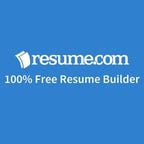
Just like the job market, resume writing is constantly changing. From new formats to key terms, it can be hard to keep up with the trends, let alone keep your resume up-to-date with your experience. Whether you want to put your best foot forward applying for your dream job or you just need some writing help, we found the best resume writing services to get you that interview ASAP.
Some of what you'll need to include in your resume will depend on the industry you want to work in. While it can vary, employers will likely look at your education, work history and skills. We've combed through dozens of resume services looking at the most helpful features across a variety of needs. We looked especially closely at the number of custom templates, the amount of guidance the service offered, the ease of navigation and the robustness of the service's privacy policy. Each of these templates and professional writing services will help you create a complete resume that best reflects your skills and experience at an affordable price.
What’s the best resume builder website?
The best resume template and builder should give you a variety of options to customize your resume. Resume.com has many options and customization features that make it a useful tool for almost any candidate applying to any job. You can upload and edit an existing resume, customize an available template from its collection or let the service guide you through creating one from scratch. Resume.com also offers helpful guidance throughout your resume creation process, making sure you include and optimize all your content. Once you're happy with your resume, you can download it for free in multiple formats.
Depending on where you're at in the job application process, you might need more guidance than a template. These professional writing services will pair you with experienced writers and coaches to help you craft and perfect resumes, LinkedIn profiles, cover letters and more. These services include more personalized coaching and features, but they tend to be more expensive. We’ve collected a range of options for your budget and needs. Because your resume likely includes your contact information and some personal information, we've also included information about each service's privacy policy.
Best resume templates and builders of 2024

A well-constructed resume can help you stand out during a job search.
- Can create new resume or customize templates
- Many free features, guidance while writing
- Integrated with Indeed job search site
- Difficulty unsubscribing from paid services
Best free resume builder
Resume.com is a free resume writer offering dozens of templates for creating your resume or cover letter, as well as job boards and career advice. You have the option to upload and edit an existing resume, create a new one, or customize one of the sample resumes offered on the site. It's intuitive and easy to use, and it creates a professional-looking final product.
When starting from scratch, you'll go section by section, entering your education, employment history, hobbies and interests, professional skills, languages and references. Resume.com provides question prompts and tips for guidance, as well as career-specific examples you can add if you're struggling to find the right words. You can also choose to forgo any of these sections, rearrange sections and add custom ones depending on what you need. As you update and save each section, you can see how it will appear on the page on your resume preview to the right. You can also change the template, font style and size, or spacing at any time and see it update in real-time in the preview.
Once you're done, you can download your new resume (in PDF, DocX, RTF or TXT format), create a custom URL or print it out. You also have the option to upload it to Indeed, a job search site that partners with Resume.com . The account you make will work with both Indeed and Resume.com . On the privacy side, the site does collect user information. If you want to delete your account, simply click your profile icon and then Account . Clicking Close My Account deletes your account and your data. If you didn't make an account, you can still choose Delete Guest Data . You can also request your data, and the company will send you an email with what it has collected.
On the review site Trustpilot , Resume.com only has 38 reviews, but of those, 53% of them awarded the site four or five stars. Some negative reviews speak of difficulty unsubscribing from paid services, so read carefully as you use the free aspects of this service.
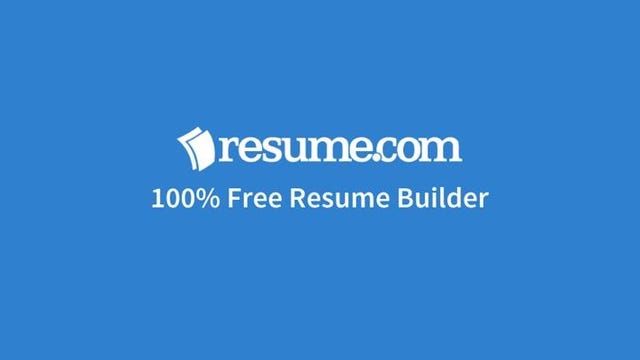
- Guided help writing work experience descriptions
- Cover letter and CV help
- Easy to change layout and color styles
- Must pay to download resume
Best option for your first resume
Resume genius.
The website Resume Genius says you can "make a professional resume in 12 minutes." We tested it out and indeed had a solid first draft of an easy resume completed in about 10 minutes. Resume Genius takes you step-by-step through the process, prompting you with questions about your education and work experience to help you fill out the applicable sections. Resume Genius is particularly helpful because you can search for a job and see prewritten text for the description that you can add or edit. When finished, you can easily toggle between different templates to see what looks best for the final product. You also have the option to directly share your resume with Indeed or Resume Library.
The site can also help you build cover letters and curriculum vitae. After you input all your information, you can choose different layout styles and colors. It's easy to move through, but you have to do it in order and fill in all the information before continuing. Resume Genius also offers examples of resumes, CVs and cover letters for specific jobs, as well as recommended jobs near you. You can download the resume you create for $3 (which starts a 14-day trial for Resume Genius Pro), or $8 (which kicks off a monthly subscription plan).
On Trustpilot at the time of this publication, the site has 4.6 out of 5 stars based on more than 38,000 reviews. Note that if you register on the site, Resume Genius does collect personally identifiable information and may share it with third parties for advertising and other purposes, according to its privacy policy. The account deletion process is buried in the Terms of Service . According to Resume Genius, complete data erasure can take up to 30 days, but they may retain "certain information in accordance with privacy laws."
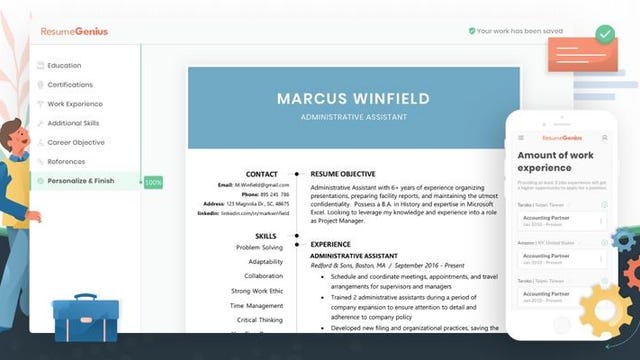
- Easy to customize
- Free downloads
- Optional paid extra assistance with Indeed professionals
- Unclear how to delete personal information
Easiest resume builder to use
Indeed resume builder.
It's free to create a resume or post your current resume on Indeed. If you're building a new one, you can choose between eight templates. The resume sections are highlighted and when you click, each section expands specific text fields. You can swap templates at any time without losing your work, as well. There are also options for toggling sections on and off, in addition to rearranging them. When you're finished, you can download a free PDF of your work history.
Indeed Resume Builder also offers optional professional advice for your new resume. After you download the resume you created, you'll get a prompt and can click Get Resume Help From a Real Person. For $35, you can upload your resume and get feedback from a professional to get you started, and for $55 you can chat with a professional in real-time via a 20-minute video call. If you're really stuck, you can opt for the full resume rewrite for $155.
Indeed's privacy policy says that it does collect and share user data with third-party providers to connect job seekers with employers and improve services. According to Indeed's privacy policy, you can request an account or personal data deletion and request that your data not be shared while your account is active. CNET reached out to Indeed for more information and we'll update when we hear back.
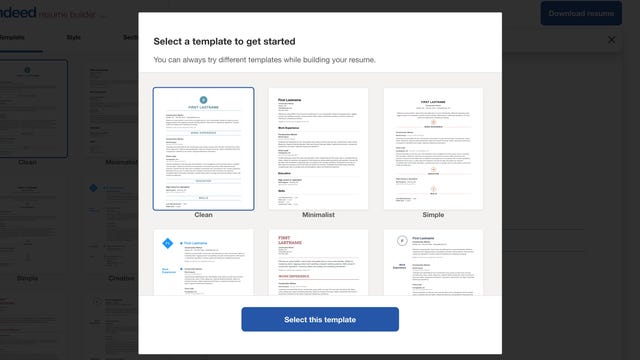
- Guides resume creation
- Free resume downloads
- Paid tier offers interview advice and cover letter builder
- Have to pay for additional downloads
Most affordable paid resume builder
Cv engineer.
CV Engineer is an easy-to-use smartphone app that creates a professional-looking resume. With 16 templates to choose from, you can tap to enter information into all of the usual sections and add custom ones. When you tap on each section, you can tap through the bottom toolbar to get advice on what type of information to add, as well as view resume examples to show you how the section could look.
CV Engineer lets you send or download your first completed resume for free, but upgrading to CV Engineer Pro for a one-time payment of $6 gives you access to unlimited downloads. A Scan My CV feature is also included, which can detect common mistakes and suggest improvements, such as places where you can add more information. The Pro version also offers interview advice and a cover letter builder.
You can download CV Engineer from the Apple App Store and Google Play Store . CV Engineer does collect personal information and can share it with Google Play Services and Firebase Analytics, according to its privacy policy. The app is free to download and ad-free.
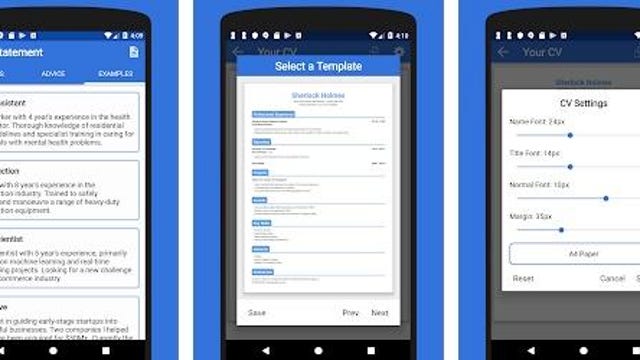
- Strong privacy policy
- Example resumes available
- Only one layout available
- Little guidance during creation
Best free iOS resume builder
Resume star 2: pro cv designer.
Resume Star 2 isn't the most visually stunning resume design app for iOS, but it gets the job done. To use, tap each section of the resume, fill in your information and it will fill in a traditional template (you only get one layout). The app offers some example resumes you can start with and edit as needed, including job-specific ones for a: cashier, dental hygienist, receptionist, waitress, mechanic and senior manager.
You can add or delete any sections you like without needing to hit save every time you add information, and you can see your resume update as you go. The autosave feature makes it easy to toggle quickly between the different sections as well. At the end, you'll have a basic resume ready to go. The app's interface doesn't offer as much guidance about how to write your resume or what types of information to include. If you need extra help, tap the information icon in the bottom left and choose the Resume Writing Guide. This will open up a crash course on resume writing in your mobile browser. It also includes a job search feature.
The app collects payment via donations after you use the service. You don't have to pay if you don’t want to. The app connects to iCloud, and you can export your resume as a PDF to any location on your device(s). If you are happy with the service, you pay $25 for it. Resume Star 2 has a 4.8 out of 5 rating, and more than 1,800 ratings in the App Store . The first version, Resume Star: Pro CV Maker, which is the same except for the iCloud connection, had a 4.9-star rating and more than 16,000 reviews. The site does not collect personally identifiable information without user consent, which seems to make it one of the more secure options available.
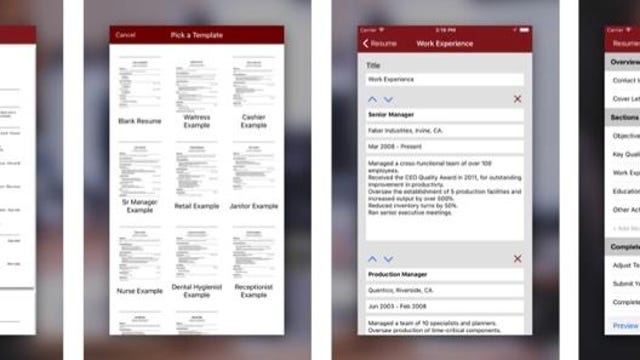
- 42 templates to choose from
- Easily customizable
- Little to no guidance during creation
Best free Android resume writing service
Intelligent cv resume builder app.
Intelligent CV's Resume Builder App offers 42 resume templates and allows you to change font colors. Each resume section appears on a list, and you can move through sections in whichever order you choose, save and go on to another. You also have the option to add, delete or rearrange sections such as education, experience and skills. There’s a Help icon in each section for a little bit of extra guidance. Once you're finished, you can download your document for free as a PDF, which you can then save on your device or send via email or text.
On the downside, the app is ad-supported and ads for other resume creators do pop up, which can get confusing. The app also offers less guidance than some of the other services, which means it's not a great option if you're new to resumes. Resume Builder App has one of the strongest privacy policies of the bunch. The app does not collect personally identifiable information , though third-party services (including Google Play services and analytics firms) may collect information. The app has 4.6 out of 5 stars and more than 424,000 Google Play Store ratings and is free to download.
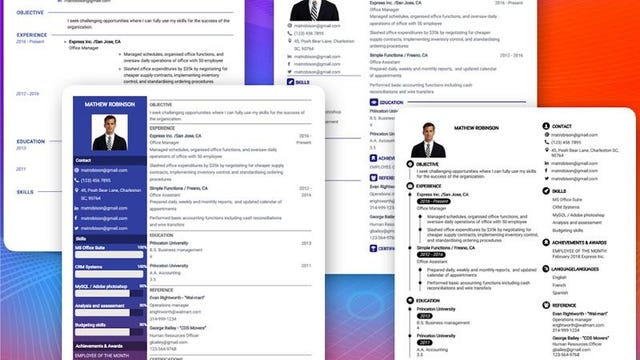
- Easy-to-use interface
- Inclusive premium package
Best range of professional tools
VisualCV has an easy-to-use interface that lets you build your resume in the way that works best for you. After signing up, you can upload an existing resume, begin with a prewritten sample or start entirely from scratch. You can use the basic editor to input information in a list form, the visual editor to edit directly on the resume and preview mode to see changes made on either version in real time. Revision history is also available. The free basic edition allows you to select from over a dozen professional templates to create, edit and download one resume as a PDF. You can also create one free cover letter and apply to jobs through its job search feature.
To download or share additional resumes, you’ll need to buy VisualCV Pro for $15 a month quarterly or $24 a month monthly. Upgrading unlocks more templates, unlimited creations, downloading, career tracking and the ability to build a personal resume website. The website URL goes through VisualCV but can be shared online. In terms of privacy, VisualCV's policy says that it does not sell, trade, rent or license personal information to third parties. As of publication, VisualCV has 4 out of 5 stars on Trustpilot but only 131 reviews.
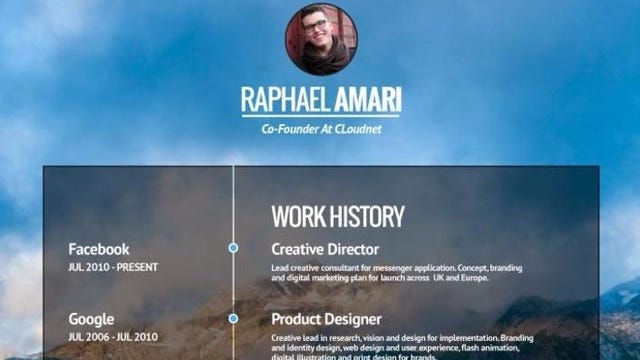
Best professional resume writing services of 2024
Depending on where you're at in the job application process, you might need more guidance than a template. These professional writing services will pair you with experienced writers and coaches to help you craft and perfect resumes, LinkedIn profiles, cover letters and more. As these services include more personalized coaching and features, they tend to be more expensive. We've collected a range of options depending on your budget and needs. Best professional resume writing services of 2024.
- Resume writing and career coaching
- Builds your resume from the ground up
- Quick turnaround
- More expensive options
A premium option for a tailored resume
Resume spice.
Suppose you're totally lost and are willing to invest several hundred dollars into your job search. In that case, Resume Spice is a resume writing and career coach service created by recruiters that connects you with a "resume expert" to build your CV from scratch.
Once you choose, you'll fill out a short questionnaire and schedule a phone consultation with a resume expert to discuss your experience, job search and career goals. The expert will take that information and turn around a personalized resume draft within two business days. You can review the draft and request any changes, and you'll get the final version in PDF and Word formats.
An entry-level resume costs $479, a professional resume costs $589 and an executive resume costs $699. In addition to these packages, you can also add a cover letter, LinkedIn profile, interview coaching or other services to help you be more competitive in the job market.

- 60 day interview guarantee
- Industry-specific advice
- Variety of packages
- Limited non-resume add-ons
A 60-day interview guarantee
Resumewriters.com.
ResumeWriters.com offers a guarantee: If you don't get a job interview with a potential employer within two months of getting your new resume, they'll rewrite it for free. The service claims that in the 20 years and tens of thousands of resumes completed under this guarantee, it averages fewer than five requests for rewrites per year. To use the resume writing service, submit your current resume or career information on the site, and an experienced resume writer will contact you to assess your materials and plan out what you need. You'll get a first draft back within 72 hours and can work with the writer on revisions until you're satisfied with the result.
ResumeWriters offers student, professional, executive and career-change resume services, as well as CV services for those conducting their job search in fields specific to the military, IT and research. The resume services cost $170 for students and $200 for the professional level, with a cover letter, one-on-one consultation and LinkedIn profile. The career change level ($250) is a comprehensive package that includes everything plus a post-interview follow-up letter, and the highest tier is the executive package that guarantees applicants its most experienced writers for $300.
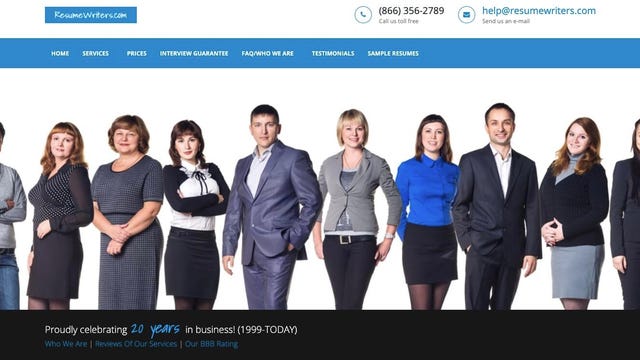
- ATS screening
- Unlimited revisions
- Longer turnaround time (3-7 business days)
A fast pass through HR screening software
ZipJob’s professional resume writers optimize your resume to get through the applicant tracking system (ATS) software used by the majority of employers to automatically scan and sort resumes. An expert writes your resume and scans it through the ATS to ensure it will make it through to the hiring manager's desk. To use the service, upload your resume or fill out a form to start from scratch. You'll be matched with a professional resume writer who will work with you to improve it and will then scan the final product to make sure it passes through the screening algorithms. Depending on which package you choose, your resume will be ready in three to seven days.
You can choose from three packages: Launch (resume writing and unlimited revisions for $139), Fast Track (adds a cover letter and a 60-day interview guarantee for $189) or Premium (adds a top resume writer, LinkedIn profile optimization, future resume updates and expedited delivery for $299).
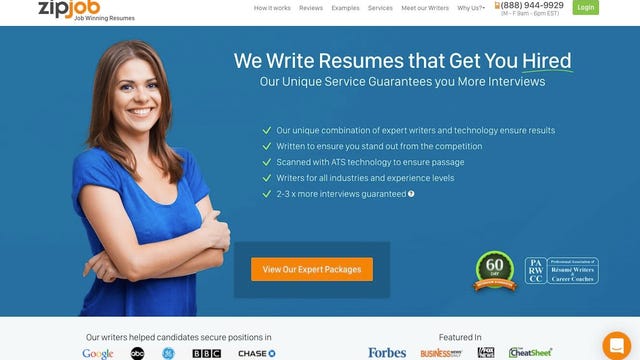
- Career coaching
- Industry-specific feedback
- Ability to customize packages
- Longer turnaround time (3-5 business days)
An executive resume solution
Find my profession.
Find My Profession offers professional resume writing services as well as career coaching. Every resume gets reviewed by two different consultants. You'll find packages that include entry-level, professional, C-level and executive resume writer services, as well as federal. In each, you can choose a base, premium or VIP package depending on your needs.
For example, the professional resume package starts at $595 for a resume compatible with automated systems. You can also add help with a cover letter for an additional $119 or a LinkedIn profile for $399. You'll get the first draft of your resume within three to five business days after you consult with a writer. Or, upgrade to a priority service for another $149 to get it within 48 hours.
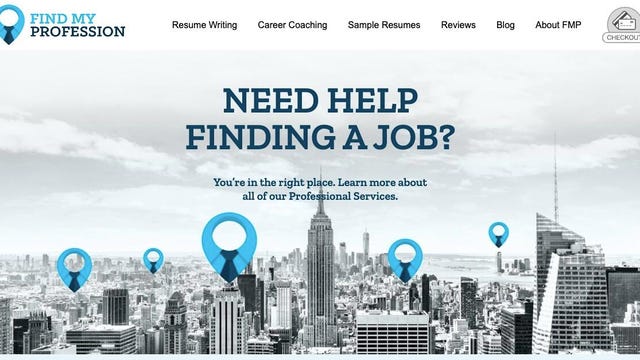
How we tested resume sites and services
When we evaluated the different resume templates and builders, we looked at how each site or app allowed you to create new resumes, browse templates or upload and edit existing resumes. We also looked at how easy or hard it would be to customize different templates and sections, how much guidance was available, how user-friendly it was to navigate, plus reading and understanding each company's privacy policies.
Some of our picks are free, some enlist the help of professional writers and some require a subscription or one-time payment. When it comes to premium or paid services, we evaluated how inclusive its packages were compared to basic or free versions. In many cases for the professional writing services, these paid tiers included more guidance and additional job search support like a cover letter and LinkedIn editing, suggested jobs to apply to and interview coaching.
Factors to consider when choosing a resume writing service
This was a key factor when compiling this list. Whether you're looking for a free service to boost your current resume or interested in professional editing services, there’s something for everyone’s price range.
Ease of use
When looking at each website, we looked at how easy it was to navigate, browse templates and add, edit or remove different sections. We also considered whether you can download and share your resume for free and in what format.
Customization options
Customization options were essential, as everyone's resume is going to look different. Having easy user control over your resume helps you create a resume that meets your industry's standards and showcases your professional experiences.
Privacy policies
Privacy policies were the final important factor to consider, as many of these are websites and apps that can collect and store your personal information. All of the services and websites included on this list have decent privacy settings, and we noted which ones have exceptionally clear use cases and account deletion policies.
Resume writing FAQs
What is a resume builder.
A resume builder is a company that has a website or app that helps you create and customize your resume. You can use preexisting templates or create your own from scratch.
What is a resume writing service?
A resume writing service is a company that pairs you with a coach or writer to work with you to create, perfect and tailor your resume, cover letters and other job application materials. These tend to be more inclusive packages and therefore more expensive than simple resume template websites.
What is the best resume format to use?
The best format for your resume is going to depend on the job you are applying to, along with your work experience. Resume templates can help you format and include all the necessary information like your education, work experience, skills and contact information.
Services and Software Guides
- Best iPhone VPN
- Best Free VPN
- Best Android VPN
- Best Mac VPN
- Best Mobile VPN
- Best VPN for Firestick
- Best VPN for Windows
- Fastest VPN
- Best Cheap VPN
- Best Password Manager
- Best Antivirus
- Best Identity Theft Protection
- Best LastPass Alternative
- Best Live TV Streaming Service
- Best Streaming Service
- Best Free TV Streaming Service
- Best Music Streaming Services
- Best Web Hosting
- Best Minecraft Server Hosting
- Best Website Builder
- Best Dating Sites
- Best Language Learning Apps
- Best Weather App
- Best Stargazing Apps
- Best Cloud Storage
- Best Resume Writing Services
- New Coverage on Operating Systems
More From Forbes
How to hire a resume writer and not get duped.
- Share to Facebook
- Share to Twitter
- Share to Linkedin
Be careful writing your resume. Some won't get through an employer's Applicant Tracking System.
Sarah called today because she said her friend's friend in HR recommended me. She had previously paid $500 to have her resume "professionally written." She lost her job back in March. To date, she has not had one response from the resume. The company that created it blamed the economy last week when she complained. She asked me to review it and tell her what was wrong.
As I dissected his resume, I knew immediately that the fancy design would never get through the Applicant Tracking System. (Read my Last Forbes Post: Are Employers Ignoring Your Resume? 5 Mistakes to Avoid . ) I also noted another cardinal sin. The company used an outdated template, did not uncover her accomplishments, and likely had little business or industry knowledge. Sarah said the salesman talked to her for 30 minutes, took notes, and passed it on to the writer. She never spoke to the writer. Good resume writers, I told her, spend a few hours with you to uncover your experience and ask you probing questions. To all this, she said, "Yeah, I had some doubts. I guess you really do get what you pay for."
Another prospective client, Dave, showed me his resume that he'd paid $400 for. It was creative and fancy looking but would mostly all disappear in the ATS. It also lacked any specific details on how he had excelled in his past roles. He said he had just spoken to a salesperson and only spent 20 minutes talking to the writer who seemed very young. Two weeks later, the resume arrived. It failed to get him any interviews – hence the call to me.
Buyer beware!
COVID-19 has brought out resume writers in full force. Some lack hiring experience. Many know very little about the ATS. Others know nothing at all. Often, they just have good writing skills. They could be a person who did a little hiring, and they see the flood of unemployed and rush to say, "Yeah, I can do that." Others may be able to create fancy, creative-looking designs, but that is all they are designs, not resumes . Ineffective, but pretty.
I went to a few advertised resume writing websites, and one had started in March. (First clue!). Their website says the right things. It advertised: "our team of career experts and Fortune 500 recruiters put together resume examples for 250+ job titles that will impress hiring managers and pass the Applicant Tracking System (ATS) scans." They showed examples of their work. On close inspection, they were making these mistakes :
Best Travel Insurance Companies
Best covid-19 travel insurance plans.
· Not ATS friendly
· No keywords
· Used color ink and a lot of shading
· Had tables, columns, text boxes
· Used headers and footers
Guidelines to follow before you lay down your money
Many people want to hire someone to help them create an effective resume. Some genuinely talented individuals know how to create a resume and get employers' attention. Understandably, you may lack the ability to create a terrific resume on your own. And asking your manager for help isn't often useful unless that person is in HR and does the company's recruiting.
Knowing how to write a resume is much different than just reviewing many. First, the professional writer needs to have strong knowledge of many careers and the job duties required in each role. It takes wordsmithing skills and personal branding ability. Most importantly, it requires the writer to understand how ATS works and the knowledge to know which keywords to add.
I've been a career counselor and resume writer for twenty-five years. I have written 5, 000 resumes in my career, and I spend no less than 3 hours talking to the client to create each one of those resumes. I would never hire anyone that I didn't speak directly with to discuss this project before agreeing to pay them to do the writing for you. Also, I recommend you use these guidelines to help you make the right decision on who to hire.
· Ask for a referral. Have any of your friends or colleagues used a writer that they liked? Did the resume work and helped them get interviews? Go to the referral's website and check them out. Start with that name and then continue your research checking on the following.
· Review background, education, qualifications, credentials. Typically, a resume writer is a career counselor, former recruiter, has HR hiring experience, and are college-educated. Do they have a Bachelor's Degree? A Master's? In what? A few have written resume writing books, others write job search articles or blogs and cover resumes. Some hold resume writing certifications offered by professional associations, like the National Resume Writers Association.
· Years of experience. You don't want a newbie. How long have they been writing resumes? Look for someone who has done resume writing for no less than FIVE years. Ask how many people they have helped. Some offer samples, look those over.
· Ensure they know your career path, industry, and job title. Work with someone who has expertise in writing a resume for your job level, job title, and is knowledgeable about your industry. Some people specialize and work only with lawyers or engineers. Others have more expertise and help people in various fields and have assisted people in your career role.
· No one can create a good resume without talking to you directly. Much of the information needed to improve your resume is in your head and must be uncovered by talking to you directly. Be sure that the person you speak to is the one who writes the resume. Be careful about being sold by the company owner who has excellent credentials but doesn't do the work. Beware of the savvy salesperson who also will pass you on to someone else to write it. The amount of time it takes to gather the info varies, but for most professionals and executives, you need a 2-3 hour conversation with the writer.
· How long will it take to get it? You should expect to get the resume back within 48 hours.
· What is the review process? Explore this policy. They write it, and you should have the option to review it and be able to make changes, corrections, and additions if needed before completion.
· Pricing: Resume writing comes in all price points, but it is the effectiveness of the end product that is critical. Lowered priced services likely won't deliver. I surveyed several resume writers with excellent qualifications to determine their prices to create a resume for professionals, managers, and executives. The results showed that you should expect a professionally written resume to cost between $800-$2400. (Note the fees seem to be much less if you are a new grad.)
· Testimonials. The writer should have several endorsements from happy customers on their website. Also, look at their LinkedIn profile to see if people endorsed the SKILLS section for resume writing.
This is a significant investment in yourself and your career. Shop carefully.

- Editorial Standards
- Reprints & Permissions
How to Make a Resume in 2024 | Beginner's Guide

For most job-seekers, a good resume is what stands between a dream job and Choice D. Get your resume right, and you’ll be getting replies from every other company you apply to.
If your resume game is weak, though, you’ll end up sitting around for weeks, maybe even months, before you even get a single response.
So you’re probably wondering how you can write a resume that gets you an interview straight up.
Well, you’ve come to the right place!
In this guide, we’re going to teach you everything you need to know about how to make a resume, including:
- The 8 Essential Steps to Writing a Resume
- 11+ Exclusive Resume Tips to Up Your Resume Game
- 27+ Real-Life Resume Examples for Different Professions
….and more!
So, let’s dive right in.
How to Make a Resume (The Right Way!)
Before we go into detail about how you should make a resume, here’s a summary of the most important steps and tips to keep in mind:

- Choose a resume format carefully. In 99% of cases, we recommend the reverse-chronological format .
- Add the right contact details. Leave your headshot out and make sure to include your job title , a professional email address, and any relevant links. (E.g.: your LinkedIn profile , online portfolio, personal website, etc.).
- Write an impactful resume summary. Unless you’re an entry-level professional, always go for a resume summary. If you do it right, it’s your chance to get the hiring manager to go through the rest of your resume in detail.
- Pay attention to your work experience section. Take your work experience section from OK-ish to exceptional by tailoring it to the job ad, making your achievements quantifiable, and using action verbs and power words.
- Add the right skills for the job. Keep this section relevant by only including the hard and soft skills that are required for the position.
- Keep your education short and to the point. Your most recent and highest degree is more than enough for a strong education section. You only need to add more details here if you’re a recent graduate with barely any work experience.
- Leverage optional resume sections. Optional sections like languages, hobbies, certifications, independent projects, and others can set you apart from other candidates with similar skills and experience.
- Include a cover letter. That’s right, cover letters matter in 2024, and the best way to supplement your resume is by adding an equally well-crafted cover letter to your job application. To make the most of it, check out our detailed guide on how to write a cover letter .
To get the most out of our tips, you can head over to the resume builder and start building your resume on the go as you read this guide.
New to resume-making? Give our ‘7 Resume Tips’ video a watch before diving into the article!
#1. Pick the Right Resume Format
Before you start filling in the contents of your resume, you have to make sure it’s going to look good.
After all, the first thing hiring managers notice is what your resume looks like, and then they start reading it. So, this is your best chance to make a great first impression.
Start by choosing the right resume format.
There are three types of resume formats out there:
- Reverse-chronological. This is by far the most popular resume format worldwide and, as such, it’s the best format for most job-seekers.
- Functional. This resume format focuses more on skills than work experience. It’s a good choice if you’re just getting started with your career and have little to no experience in the field.
- Combination. The combination resume format is a great choice for experienced job-seekers with a very diverse skill set. It’s useful if you’re applying for a role that requires expertise in several different fields and you want to show all that in your resume.
So, which one should you go for?
In 99% of cases, you want to stick to the reverse-chronological resume format . It’s the most popular format and what hiring managers expect to see. So, in the rest of this guide, we’re going to focus on teaching you how to make a reverse-chronological resume.

Fix Your Resume’s Layout
With formatting out of the way, let’s talk about your resume’s layout , which determines the overall look of your resume.
Does it look organized or cluttered? Is it too short or too long? Is it boring and easy to ignore, or is it reader-friendly and attention-grabbing?
Here are some of the best practices you should apply:
- Stick to one page. You should only go for a two-page resume if you have decades of experience and you’re sure the extra space will add significant value. Hiring managers in big companies get hundreds of applications per job opening. They’re not going to spend their valuable time reading your life story!
- Add clear section headings. Pick a heading and use it for all the section headers so the hiring manager can easily navigate through your resume.
- Adjust the margins. Without the right amount of white space, your resume will end up looking overcrowded with information. Set your margins to one inch on all sides so your text fits just right on the page.
- Choose a professional font. We’d recommend sticking to a font that’s professional but not overused. For example, Ubuntu, Roboto, or Overpass. Avoid Times New Roman, and never use Comic Sans.
- Set the correct font size. As a rule of thumb, go for 11-12 pt for normal text and 14-16 pt for section titles.
- Use a PDF file. Always save your resume as a PDF file, unless the employer specifically requests otherwise. Word files are popular, but there’s a good chance they’ll mess up your resume’s formatting.
Another thing you need to consider in terms of your resume’s layout is whether you’re going for a traditional-looking resume template or something a bit more modern :

If you’re pursuing a career in a more traditional industry, like law , banking , or finance , you might want to stick to the first.
But if you’re applying to a tech company where imagination and innovation are valued, you can pick a more creative resume template .
Want to Save Time? Use a (Free) Resume Template
Anyone who’s ever tried creating a resume from scratch knows how boring the formatting can be.
Before you can even start filling in the contents, you need to tweak the margins, adjust font sizes, and make sure everything fits into one page while still looking good.
What if you could skip past all that and still create a compelling resume?
Try one of our free resume templates . They’re pre-formatted, so all you have to do is fill in the contents.
They’re also created in collaboration with recruiters from around the globe, ensuring that the templates are visually appealing and ATS-friendly!
See for yourself how one of our templates compares to a resume created in a standard text editor:

#2. Add Your Contact Information
Now that we’ve got all the formatting out of the way, let’s get into what your resume is all about— the information you put on it .
The first thing you want to do when filling out the contents of your resume is to add your contact information .
This section is pretty straightforward but crucial. Your contact details belong at the top of your resume in a designated resume header , so the hiring manager can easily find them.
Even if everything else about your resume is perfect, that all flops if you misspell your email address or have a typo in your phone number. If the hiring manager can’t contact you, it’s a missed opportunity.
So, double-check, and even triple-check your contact information section and make sure everything is factually correct and up-to-date.
Must-Have Information
- Full name. Your first and last name should stand out at the top of your resume.
- Email address. Stick to an address that’s professional and easy to spell, like a combination of your first and last name. (E.g.: [email protected])
- Phone number. Add a reliable number where the hiring manager can easily reach you.
- Location. Add your city and state/country. If you plan to relocate for the job or want a remote position, specify it on your resume.
Optional Information
- Job title. Add your professional title underneath. Write it down word for word, whether it’s “Digital Marketing Specialist” or “Junior Data Scientist.” Just don’t make up job titles like “Marketing Wizzard” or “Data Manipulator.” They’re not quirky; they’re just unprofessional.
- LinkedIn profile . We recommend that you include a link to your updated LinkedIn profile since over 77% of hiring managers use the platform when evaluating a candidate.
- Relevant links. Include links to personal websites or any social media profiles that are relevant to your field. For example, a developer could include a Github profile, while a graphic designer could link their Behance or Driblle account, and so on.
- Date of birth. Unless this is specifically required in the job ad, the hiring manager doesn’t need to know how old you are. It’s not important for their decision-making, and at worst, it might lead to age-based discrimination.
- Unprofessional email address. Your quirky, old high school email address doesn’t belong on your resume. Instead of [email protected] , go for a [email protected] type of address.
- Headshot. (USA, UK or Ireland) Depending on the country where you’re applying, it might even be illegal to include a picture of yourself on your resume . While it’s the norm to include a picture in most of Europe and Asia, always check the regulations for each specific country or industry you’re applying to.
All clear? Good! Now, let’s look at what a great example of a resume's contact information section looks like:

#3. Write a Resume Headline (Summary or Objective)
It's no secret that recruiters spend an average of less than seven seconds on a resume .
When you receive hundreds, if not thousands, of applications daily, it's physically impossible to spend too much time on each.
So, what the hiring managers do to go through resumes more effectively is to skim through each resume and read it in depth only if it piques their interest.
This is where the resume headline comes in.
Placed right next to (or underneath) your contact information, this brief paragraph is the first thing the hiring manager is going to read on your resume.
Now, depending on how far along in your career you are, your resume headline can be either a resume summary or a resume objective.

So, how do you choose between a resume summary and a resume objective? Here’s all you need to know:
Resume Summary
A resume summary, as the name suggests, is a two to three-sentence summary of your career so far. If done right, it shows that you’re a qualified candidate at a glance and gets the hiring manager to give you a chance.
Here’s what your resume summary should include:
- Your job title and years of experience.
- A couple of your greatest professional achievements or core responsibilities.
- Your most relevant skills for the job.
Here’s an example of a well-written resume summary:
Experienced Java Developer with 5 years of experience in building scalable and efficient applications. Contributed to a major project that enhanced application performance by 25%. Strong background in Spring Framework and microservices. Aiming to apply robust coding skills to develop innovative software solutions at XYZ Tech Solutions.
Unless you’re a recent graduate or amid a career change, we recommend you stick to a resume summary. Otherwise, a resume objective might be a better option for you.
Resume Objective
A resume objective is supposed to express your professional goals and aspirations, academic background, and any relevant skills you may have for the job.
It communicates your motivation for getting into a new field, so it’s the go-to headline for recent graduates and those going through a career change. As with a resume summary, a resume objective should be brief—around two to four sentences long.
So, here’s what it would look like if you’re a student:
Hard-working recent graduate with a B.A. in Graphic Design from New York State University seeking new opportunities. 3+ years of practical experience working with Adobe Illustrator and Photoshop, creating illustrations and UX/UI design projects. Looking to grow as a designer and perfect my art at XYZ Design Studio.
Or, on the other hand, if you’re going through a career change, it might look more like this:
IT project manager with 5+ years of experience in software development. Managed a team of developers to create products for several industries, such as FinTech and HR tech. Looking to leverage my experience in managing outsourced products as a Product Owner at Company XYZ.
#4. Prioritize Your Work Experience
The most important part of your resume is your work experience.
This is where you get to sell yourself and show off your previous accomplishments and responsibilities.
If you manage to master this section, you’ll know most of what’s there to know about how to make a resume.
There are plenty of good practices for writing your work experience . But before we dive into all the nits and grits, let's start with the basics.
The standard format for each work experience entry is as follows:
- Job title/position. Your job title goes on top of each work experience entry. When the hiring manager looks at your resume, you want them to know, at a glance, that you have relevant work experience for the job.
- Company name/location/description. Mention the name of the employer and the general location, such as the city and state/country where you worked. In some cases, you may also want to briefly describe the company, like when the organization isn’t particularly well-known.
- Dates employed. Add the approximate timeframe of your employment at each company. You don’t need to give exact dates since the standard format for this is mm/yyyy.
- Achievements and responsibilities. This is the core of each work experience entry. Depending on your field, you want to list either your achievements or responsibilities. List them in bullet points instead of paragraphs, so they’ll be easier to read.
Here’s a real-life example:

Your work experience entries should always be listed in reverse chronological order , starting with your most recent job and working your way back into the past.
Now that you know how to list your experience, we’re going to show you how to write about it in a way that makes you stand out from the competition, starting with:
Are you a student with no work experience? We’ve got you covered. Check out our guide to writing a resume with no experience here.
Focus on Achievements Whenever Possible
One of the most common resume mistakes is only listing responsibilities in your work experience section.
Here’s the thing—in most cases, the hiring manager knows exactly what your job responsibilities are.
For example, if you’re a sales manager, your responsibilities would be:
- Reach out to potential clients over the phone or email.
- Maintain relationships with existing company clients and upsell relevant products.
- Tracking and reporting on leads in CRM.
Coincidentally, this is also the same list of responsibilities for every sales manager out there. So, 90% of all other resumes probably mention the same thing.
To stand out from the competition, you want to focus on writing achievements in your resume instead. These can be how you helped your previous company grow, reach quarterly quotas, and so on.
Let’s compare how responsibilities hold up next to achievements for the same job:
- Exceeded sales team KPIs by 30%+ for 3 months straight.
- Generated over $24,000 in sales in 1 month.
- Generated leads through cold-calling
- Managed existing company clients
Keep in mind, though, that in some fields, there just aren’t that many achievements you can mention. Let’s say you’re a warehouse worker .
Your day-to-day responsibilities probably include:
- Loading, unloading, and setting up equipment daily.
- Packaging finished products and getting them ready for shipping.
- Assisting in opening and closing the warehouse.
In fields like this, it’s pretty hard to distinguish yourself through achievements, so it’s okay to stick to responsibilities instead. You can still make them shine by following the rest of our advice about listing your work experience.
Keep in mind, though, that in some fields, there aren’t that many achievements you can mention. Let’s say you work in a warehouse. Your day-to-day responsibilities probably involve:
- Loading, unloading and setting up equipment on a daily basis.
- Package finished product and get it ready for shipping.
- Assist in opening and closing the warehouse.
In such fields, it’s pretty hard to distinguish yourself, so it’s totally OK to stick to responsibilities instead.
Tailor Your Resume to the Job
Tailoring is what sets an amazing resume apart from an okay one.
Hiring managers don’t need to know about every single job you’ve ever worked at or every single skill that you have.
They only want to know about your jobs, experiences, or skills that are relevant to the role you’re applying for.
For example, if you’re applying for a job doing Google Ads, you don’t need to talk about your SEO internship from eight years ago.
By focusing your resume on whatever is important for the specific role, you’re a lot more likely to stand out and catch the hiring manager’s attention.
Let’s take a look at an example of a job ad:

As you can see, we’ve highlighted the most important requirements.
To tailor your resume accordingly, you just need to mention how you meet each of these requirements in your resume.
You can highlight your relevant achievements and qualifications in different parts of your resume, such as:
- In your resume summary, where you should recap your years of experience.
- Throughout your work experience section, where you should list achievements and responsibilities that reflect your social media marketing experience.
- In your education section, where you can let the hiring manager know you have the degree that they’re looking for.
Include the Right Amount of Work Experience
If you’ve got over a decade’s worth of work experience, you’re probably wondering whether all of it belongs on your resume. In most cases, you’d end up writing a novel if you listed everything you’ve ever done, and that’s not how long a resume should be .
If you’re new to the job market, on the other hand, you probably don’t have any experience, and you’re wondering what you could even add to this section.
So, here’s how much information your resume should include, depending on your level of experience:
- No experience. If you’re looking for your first job , you won’t have any work experience to fill this section with. So, you can either keep it empty and focus on all the other sections or fill it up with any experience gained in student organizations, extracurricular activities, volunteering, and other projects.
- Entry-level. List all your work experience so far. While some of it won’t be relevant, it can still show the hiring manager that you do have some actual work experience.
- Mid-level. Only mention relevant work experience to the position you’re applying for. There’s no need to waste space on jobs that aren’t related to what you’re after.
- Senior-level. List up to 15 years of relevant work experience, tops. If your most recent experience is as a marketing executive , the hiring manager doesn’t care how you started your career as a junior marketing specialist 23 years ago.
Consider Applicant Tracking System (ATS) Software
Did you know that over 70% of resumes don’t even make it to the hiring manager ?
Most companies these days use ATS to evaluate hundreds of resumes instantaneously and automatically filter out the ones that don’t meet their criteria.
For example, if a resume doesn’t mention a specific skill or isn’t formatted correctly, the ATS will automatically reject it.

Fortunately, there are some easy ways to make an ATS-friendly resume .
Here are a couple of tips to help you get past those pesky robots:
- Stick to one page. Sometimes employers set a limit on how long a resume should be. This means that if your resume is longer than one page, it might get automatically disqualified.
- Incorporate keywords. Tailoring your resume to the job helps a ton with beating the ATS. Just carefully read the job description to find hints for what the ATS will be looking for. Then, whenever you find keywords related to your responsibilities and achievements, make sure to include them in your work experience section.
- Use an active voice. Passive voice is too vague and unclear, so make sure to use active voice as much as possible when describing your previous jobs. (E.g.: “Managed a team of ten people,” instead of “ A team of ten people was managed by me.” )
- Leverage powerful action words. Instead of starting each of your sentences with “was responsible for," make your work experience impactful by using words that can grab attention. Saying that you “spearheaded” or “facilitated” something sounds a lot more impressive than “helped.”
Want to make sure your resume formatting passes the ATS test? Choose one of our tried and tested ATS-friendly resume templates , and you’ll be good to go!
#5. List Your Education
The next section on your resume is dedicated to your academic qualifications. Let’s start with the basics!
Here’s how you should format the education section on your resume :
- Program Name. Your major and degree type should be listed. (E.g.: “B.A. in Business Administration” )
- University Name. Add the name of the institution. (E.g.: “New York State University” )
- Dates Attended. Use a mm/yyyy format for the dates you attended. (E.g.: “08/2008 - 06/2012” )
- Location. If your university is less well-known, you can also add the location. (E.g.: “Stockholm, Sweden” )
- GPA. Use the appropriate grading system for the country you’re applying to work in. (E.g.: In the USA, it would be “3.9 GPA” )
- Honors. Add any honors and distinctions you’ve been given. (E.g.: Cum Laude, Magna Cum Laude, Summa Cum Laude )
- Achievements. You can mention interesting papers you’ve written, projects you’ve done, or relevant coursework you’ve excelled in.
- Minor. “Minor in Psychology”
Pretty simple, right? Now let’s see what an education section looks like in practice:

This example includes all the necessary information, plus an eye-catching award and relevant classes this candidate has taken.
Resume Education Tips
Now that you know how to list your education on your resume, let’s take this section to the next level.
Just follow these expert tips:
- If you’re making a resume as a student and don’t have any work experience yet, you can list your education section at the beginning of the page instead of work experience.
- You can add your expected graduation date if you’re still pursuing your degree.
- If you already have relevant work experience, just keep this section short and sweet. Recent graduates can expand on their education more and add optional information like projects, classes, academic achievements, etc.
- Always list your degrees in reverse chronological order, starting with your highest degree on top. Your highest and most recent degree is usually enough, so if you have a Master’s degree that’s relevant to the job, there’s no need to mention your earlier degrees.
- Don’t add your high school degree to your resume if you already have a university degree. It doesn’t have as much weight, and you can use the space for something else.
- Only mention your GPA if you had an impressive academic career. Anything below a 3.5 GPA doesn’t need to be on your resume.
Are you in the process of applying for college? Check out our guide to writing a college application resume to wow that admissions officer!
#6. Emphasize Your Know-How in the Skills Section
After your work experience, your skills are the first thing the hiring manager is going to look for. In fact, together, work experience and skills make up 90% of the hiring decision .
So, this is the place where you want to mention all the know-how that makes you the perfect candidate for the job.
There are two types of skills you can include when writing your resume:
- Hard Skills. These are measurable abilities. What you can list here can be anything from coding in Python to knowing how to cook Thai cuisine.
- Soft Skills. Also known as personal skills, these are a mix of communication skills , personal traits, career attributes, and more. They can include leadership, critical thinking, and time management , just to name a few.
Your resume should always cover both hard skills and soft skills . Here’s an example in action:

Now, let’s discuss how you should list your most important skills on your resume.
There are a few essential steps you need to follow:
Always List Hard and Soft Skills Separately
Your resume should be easy and neat to navigate. The hiring manager shouldn’t have to waste time looking for a specific skill because you didn’t separate it into the appropriate subsection.
So, just create separate categories for your hard and soft skills.
Depending on your field, you could customize the name of your “hard skills” subsection to something like “technical skills," “marketing skills," or something else related to your field.
Let’s look at an example of what skills look like on a project manager’s resume :
Methodologies & Tools
- Agile Methodology
- SCRUM Framework
- Waterfall Project Management
- Microsoft Project
- Critical Path Method (CPM)
- Earned Value Management (EVM)
- Risk Management
Soft Skills
- Team Management
- Conflict Resolution
- Negotiation
Tailor Your Skills to the Job
You might have some awesome skills, but the hiring manager only needs to know about the ones that are relevant to the job.
For example, if you’re applying for a job as an accountant, your gourmet chef skills shouldn’t be on your resume.
Look at the job ad and list at least two to three essential skills you have that are required for the role. Remember—there’s no need to list every skill you have here; just keep it relevant.
Qualifications:
- Bachelor’s degree or higher in Graphic Design or a related field.
- Tech-savvy, with some background in CMS systems such as WordPress.
- Thrives in a stressful environment and juggles multiple tasks and deadlines.
- Strong organizational and time management skills.
- Excellent communication skills.
- Self-reliant, with the ability to manage their own work.
- A can-do attitude and an outside-the-box thinker.
- Proficient in Adobe Photoshop, InDesign, Illustrator, Keynote, and Pages.
- Basic understanding of Office software such as Microsoft Word, Excel, PowerPoint, and Outlook.
So, the must-have hard skills here are Photoshop, InDesign, Illustrator, Keynote, and Pages. Other good computer skills to have are WordPress or similar CMS systems.
While you can also mention Word, Excel, PowerPoint, and Outlook, it’s pretty much assumed that you know how to use them since they’re required for most office jobs.
List Hard Skills with Experience Levels
For each hard skill you list on your resume, you should also mention your proficiency level. This tells employers what they can expect from you and how much training you might need.
- Beginner. You have some experience with the skill, whether it’s from some entry-level practice or classroom education.
- Intermediate. You’ve used the skill in a work environment with good understanding.
- Advanced. You’re the go-to person for this skill in your office. You can coach other employees, and you understand the skill at a high level.
- Expert. You’ve applied this skill to more than a handful of different projects and organizations. You’re the go-to person for advice about the skill, not just in your office but even amongst some of the best professionals in your field.
Just make sure to never lie about your actual skill level. Even if you get the job, once you need those skills you exaggerated, it will be pretty awkward for both you and your employer.
Include Transferable Skills
These are the types of skills that are useful for almost any job out there.
Transferable skills can be both soft skills (e.g.: teamwork, creativity, problem-solving skills, and others) and hard skills (MS Office Suite, HTML, writing, etc.)
Whatever job you’re applying to, chances are you have transferable skills from your experience that can come in handy one way or another. So, feel free to include them, even if they’re not specifically required for the position.
Not sure which skills to mention on your resume for your specific field? Check out our list of 101+ essential skills for inspiration!
#7. Leverage Optional Resume Sections
The sections we’ve covered so far are must-haves for any resume. They’re the bread-and-butter for any job application, and if you get them right, you’ll land any job you apply to.
But if you have some leftover space, there are a few optional sections you can choose from to give your resume a boost!

Are you bi-lingual? Or even better – multi-lingual? You should always mention that on your resume!
Even if the position doesn’t require you to know a specific language, it can still come in handy at some point. At the end of the day, it’s always better to know more languages than less.
To list languages in your resume , just write them down and assign them the appropriate level:
- Intermediate
You can also use the Common European Framework of Reference for Languages (CEFRL) or the American Council on the Teaching of Foreign Languages (ACTFL) proficiency scales.
As a given, you should never lie about your language skills. You never know—your interviewer might turn out to be fluent in the language or even be a native speaker!
Hobbies and Interests
If you want to spice up your resume, hobbies and interests could be just what you need.
While this section isn’t a game-changer, it can help the hiring manager see who you are as an individual.
For example, if you listed “teamwork” as one of your skills, hobbies like team sports can back up your claim.
And who knows? Maybe you and your interviewer have some hobbies or interests in common!
Volunteering Experience
If you’re the type of person who devotes their free time to helping others while expecting nothing in return, chances are that you’re the type of employee who’s in it for more than just the money.
Seeing volunteer experience on your resume tells hiring managers that you’re a loyal employee who’s after something meaningful.
Several studies show that listing your volunteer experience can boost your chances of getting hired, especially if you have little to no work experience.
Certifications
Hiring managers love candidates who invest in themselves, and that’s exactly what they see when you list certifications on your resume .
If you value continuous learning and strive to expand your skill set, that’s always a plus.
Certifications can also show employers how much expertise you have.
For example, if you’re a Microsoft Cloud Engineer and you specialize in Microsoft Technologies, you should definitely include all essential certifications on your resume, such as the Azure Solutions Architect Expert one.
Awards and Recognitions
There’s no harm in showing off a little on your resume. After all, you want to be a candidate that shines above the rest.
So, if you’ve received any awards or recognitions that make you stand out in your field, make sure to add them.
For example, if you’ve been recognized for your contributions to data science or received a hard-to-come-by scholarship , mention it in your resume. Just keep your entries here relevant to the field you’re applying to.
Publications
Whether you’re a freelance writer or a distinguished academic, publications are always impressive.
If you have any published works (online or in an academic journal), you can add them to your resume. Just make sure to include a link so the hiring manager knows where to check your work!
Are you looking for a career in academia? Check out our guide to writing the perfect academic CV to get started!
Working on side projects can show off your passion for your field. Whether they’re university class projects or part-time entrepreneurial endeavors, they’re relevant.
For example, if you worked on a mock software product as part of a university competition, it shows you went through every step of product creation, from ideation to creating a marketing strategy.
This project also shows off your organizational skills , and if you mention it in your resume, you stand a better chance of landing the job you had your sights set on.
But projects can also be personal, not academic. For example, you might manage an Etsy store where you sell hand-made arts and crafts to customers online. This is a great opportunity to highlight your creativity, management, and customer service skills .
Overall, hiring managers love employees who do cool work in their free time, so projects are always a great section to add to your resume.
Looking to kickstart your career? Check out our guide on how to get an internship for useful tips and real-life examples!
Extracurricular Activities
Every college freshman knows that extracurricular experience can make a difference in their application.
Especially if you don’t have a lot of experience outside of school, extracurricular activities are a great way to show potential employers your skills and give them insight into you as a person. Different clubs and after-school projects can help you gain real-life skills and considerably increase your chances of landing your first job after college.
For example, joining a student government organization can hone your leadership skills and teach you how to work as part of a team.
For example, if you’re part of a student government or public speaking club, these activities can help you hone your leadership and presentation skills.
11+ Expert Resume Tips
You’ve got the gist of how to make a resume. Now, it’s time to make it really stand out from the crowd!
Follow these exclusive resume tips to take your resume game to the next level:
- Match the professional title underneath your name to the job title of the position you’re applying for. Hiring managers often hire for several roles at once, so giving them this cue about what role you’re after helps things go smoother.
- Mention any promotions from your previous jobs. Use the work experience entries for them to focus on the achievements that helped you earn them.
- Describe your achievements using Laszlo Bock’s formula : accomplished X as measured by Y by doing Z . This way, your work experience can go the extra mile and show the hiring manager what you can bring to the table.
- Always list your achievements and responsibilities in concise bullet points. This makes your resume more reader-friendly, and it’s more likely that the hiring manager will see your impressive achievements at a glance.
- Don’t use personal pronouns like “I” or “me,” and don’t refer to yourself by name. Stick to a slightly altered third person, like “managed data integrity at XYZ Inc.” instead of “he managed data integrity at XYZ Inc.”
- Name your resume sections correctly, or it might get rejected by the ATS. Swapping out quirky names like “career history” or “expertise” for “work experience” and "skills" makes it easier for the hiring manager to find what they’re looking for, too.
- Prioritize important keywords instead of adding all of them. Make sure the relevant skills, qualifications, and experiences you add all make sense in context, too. Your goal is to get past the ATS and impress the hiring manager.
- Focus on transferable skills if you don’t have a lot of relevant work experience. Any extracurricular activities or personal projects can help you stand out here.
- Add a strategic pop of color to headings, bullet points, or key elements you want to highlight. It can help your resume stand out, but don’t overdo it—you want the information to be more impressive than the color palette.
- Don’t include the line “references available upon request.” Hiring managers already know they can request a list of references from you, so there’s no need to waste valuable space on it.
- Make sure your resume is optimized for mobile viewing. Most hiring managers use their mobile phones as often as desktop computers, so save your resume to a PDF file and make sure your formatting stays intact across any device.
- Rename the resume file you plan to send so it includes your name and the name of the position you’re applying for. It’s a small detail that can turn into a crucial mistake if you forget it.
- Read your resume out loud when you’re done. This is a great way to catch awkward phrases or spelling mistakes you might have missed otherwise.
- Use a tool like DocSend to track your resume. You’ll get a notification any time someone opens your resume, and you can see how long they spend reading it.
FREE Resume Checklist
Are you already done with your resume? Let’s see how it holds up!
Go through our checklist for perfecting your resume and see where you stand!

If you missed some points, just go through your resume one more time and perfect it.
And if you ☑’d everything—congrats! You’ve learned all there is to know about writing a resume, and you’re good to go with your job search.
Need to write a CV instead of a resume? Check out our step-by-step guide on how to write a CV with dozens of examples!
9 Resume Templates for Different Industries
Looking to create an effective resume without dealing with the formatting hassle? Just choose one of the templates below.
#1. Traditional Resume Template

Good for traditional industries like finance, banking, law, and manufacturing.
#2. Modern Resume Template

Good for both contemporary and forward-looking industries, including entrepreneurship, medical technology, and engineering.
#3. Creative Resume Template

Good for creative industries, including entertainment, design, and architecture.
#4. Minimalistic Resume Template

Good for experienced professionals in basically any industry who want to let their achievements do the talking.
#5. IT Resume Template

Good for any IT-related profession like software development, cyber security, and DevOps engineering.
#6. Tech Resume Template

Good for the tech industry and everything it encompasses.
#7. College Resume Template

Good for college students and recent graduates alike.
#8. General Resume Template

Good for multiple industries, including HR, education, and customer service.
#9. Executive Resume Template

Good for senior professionals across different industries, including hospitality, marketing, and logistics.
17+ Resumes for Different Jobs
Knowing how to write a resume is one thing, but making a resume that stands out is something entirely different. Without inspiration, even top career experts might stumble on a roadblock or two.
Check out the following effective resume examples for specific jobs to get a better sense of what a good resume looks like:
#1. Nurse Practitioner Resume Example

Check out our full guide to writing a nurse resume here.
#2. Data Scientist Resume Example

Check out our full guide to writing a data scientist resume here.
#3. Business Analyst Resume Example

Check out our full guide to writing a business analyst resume here.
#4. Digital Marketing Resume Example

Check out our full guide to writing a digital marketing resume here.
#5. Software Engineer Resume Example

Check out our full guide to writing a software engineer resume here.
#6. Construction Project Manager Resume Example

Check out our full guide to writing a construction project manager resume here.
#7. Customer Service Resume Example

Check out our full guide to writing a customer service resume here.
#8. High School Resume Example

Check out our full guide to writing a high school resume here.
#9. Student Resume Example

Check out our full guide to writing a student resume here.
#10. Server Resume Example

Check out our full guide to writing a server resume here.
#11. Actor Resume Example

Check out our full guide to writing an actor resume here.
#12. Web Developer Resume Example

Check out our full guide to writing a web developer resume here.
#13. Engineering Resume Example

Check out our full guide to writing an engineering resume here.
#14. Computer Science Resume Example

Check out our full guide to writing a computer science resume here.
#15. Architect Resume Example

Check out our full guide to writing a data analyst resume here.
#17. Remote Job Resume Example

Check out our full guide to writing a remote job resume here.
#18. Sales Associate Resume Example

Check out our full guide to writing a sales associate resume here.
#19. Receptionist Resume Example

Check out our full guide to writing a receptionist resume here.
Want to see more examples? Check out our compilation of 80+ resume examples for different fields .
- Administrative Assistant Resume
- Bartender Resume
- DevOps Engineer Resume
- Executive Assistant Resume
- Flight Attendant Resume
- Graphic Designer Resume
- Paralegal Resume
- Pharmacist Resume
- Recruiter Resume
- Supervisor Resume
Next Steps After Your Resume
Now that we’ve covered everything you need to know about how to make a resume, it’s time to talk about the rest of your job application.
After all, your resume is only the first step in your job search. To land the job you deserve, you also need to write a captivating cover letter and ace that upcoming interview. Here’s how:
#1. How to Write a Convincing Cover Letter
The companion piece to every resume is the cover letter.
Most job-seekers flinch when they hear that they have to write a cover letter. What do you even mention in a cover letter, anyway? If you were good at writing cover letters, you’d be applying for a job as a writer !
In reality, though, writing a cover letter is very simple once you know its purpose.
Think of your cover letter as a direct message to the hiring manager. It’s your chance to briefly explain why you’re such an awesome fit for the position. And with a few cover letter tips to point you in the right direction, you’ll write the perfect cover letter for your job application.
Just follow this structure:

- Add the contact details. Include the same contact information as on your resume, plus additional contact details for the hiring manager, including their name, job title, the company’s name, and location.
- Introduce yourself. Start your cover letter by mentioning who you are, what your work experience is, and why you’re interested in the position. Mention a standout achievement or two, relevant skills, and what you’d like to do for the company you’re applying for.
- Explain why you’d excel at the job. Find the requirements in the job ad that you meet, and elaborate on how you fulfill the most important ones. Research the company so you know what you like about it, and mention it in your cover letter. Make sure to convey your enthusiasm for the job and confidence that you’ll be a great fit for their team.
- Wrap it up politely. Conclude your cover letter by recapping your key selling points and thanking the hiring manager for their time. Then add a call to action, such as “Please don’t hesitate to reach out to me at the provided phone number so that we can discuss my application in greater detail.” Then, add a closing line and follow it with your full name.
Sounds easy, right? Here’s a real-life example to drive the point home:

Do you need more help perfecting your cover letter? Learn what the most common cover letter mistakes are and check out cover letter examples for all professions here.
#2. How to Ace Your Next Interview
Once you’ve perfected both your resume and cover letter, there’s only one thing left.
It’s time for the final step—the dreaded job interview.
Whether you’re an extrovert or an introvert, you probably hate the interviewing process. No matter how experienced you are, it can be nerve-wracking. Sitting there while someone’s prodding into your past experiences and judging you isn’t fun.
But did you know that most interviewers ask the same questions?
That’s right—all you have to do is learn how to answer some of the most common interview questions, and you’ll be an interview away from landing your dream job!
Just check out our complete guide to the 35+ Job Interview Questions and Answers and learn how to ace your next interview.
FAQs on How to Make a Resume
Do you still have some questions about making a resume? Check out the answers to the most frequently asked questions below!
#1. What does a good resume look like in 2024?
For your resume to look good in 2024, make sure it’s organized and clean and isn’t longer than one page.
Be sure to include information that adds value to your application—leave out the focus on your relevant work experience and skills that you can back up, and list as many achievements as possible.
If you’re using a resume template, choose one based on your industry. Conservative industries like law, banking, and business require more traditional resume templates. But if you’re going for an industry like design, architecture, or marketing, you can go for a creative resume template .
Remote work is also big in 2024, so if that’s what you’re after, tailor your resume to match the job you want.
#2. How do you make a resume in Word?
The best way to create a resume in Word is to use a pre-designed Microsoft Word template. To access them, you should:
- Open MS Word
- Click “file” from the menu bar
- Select “new”
- Type “resume templates” in the search bar
That said, Word resume templates are generic, hard to personalize, and overall not very stylish.
Want a resume that looks good and is extremely easy to make? Check out resume templates to get started!
#3. How do I write a resume for my first job?
If you’re writing your first-ever resume for an entry-level position, the hiring manager won’t expect you to have any work experience.
However, you can make up for your lack of experience with your skills and academic achievements.
For example, you can take advantage of extracurricular activities, internships, volunteering experiences, and other non-professional experiences. You can use them to highlight the skills you’ve gained and what you’ve achieved so far.
So, your first job resume should have a resume objective, emphasize your education, and replace your work experience with any internships, volunteering, independent projects, or other experiences.
#4. How to make a resume on Google Docs?
You can make a resume on Google Docs by choosing one of their templates and filling it in on the go.
All you have to do is go to your Google Drive’s template gallery, choose your preferred template, fill in your information, and your Google Docs resume is ready to go!
That said, Google Docs templates aren’t the most user-friendly choice. You don’t have much flexibility with the layout and formatting isn’t that easy. For example, you tweak a section to the slightest, and the whole resume becomes a mess.
If you want an easier option, check out our resume builder !
#5. What kind of resume do employers prefer?
Typically, employers prefer one-page-long resumes that follow the reverse chronological format.
Hiring managers receive hundreds of resumes every day, so they don't have the time to read three-page resumes. Try one of our one-page resume templates so you don’t go over the recommended resume length.
Meanwhile, the reverse-chronological format is the most popular because it draws attention to your most recent jobs and professional achievements, which is the #1 most important thing hiring managers look at when evaluating a resume.
#6. How many jobs should you put on your resume?
You should only include relevant job positions on your resume.
This means that your work experience section should be tailored to the job you are applying for. If you’ve worked five different jobs and they can all add value to your current application, then you should include all five.
If, on the other hand, you’re applying for, say, a customer service position and some of your past jobs don’t have anything to do with customer service, you should skip them.
#7. Should I put my address on my resume?
You can put your location (city, state, or country) on your resume, but you don’t need to put your entire physical address.
Putting a physical address on a resume was the norm back when companies would contact you via mail. In today’s world, everyone communicates via email, which is why adding a correct and professional email address to your contact information section is far more important than putting your physical address.
So, just include your location or-–if you’re a remote worker—specify you prefer to work remotely by writing “working remotely from [location].”
#8. What information should I leave out of my resume?
As a general rule, you shouldn’t include your birthday or your headshot on your resume. This norm varies from country to country but it applies to the USA, Canada, and UK.
If you have plenty of achievements to list under your work experience, then you can leave your basic work responsibilities out of your resume.
In your education section, you should only include your highest and most recent degree. So, if you hold a Ph.D., you can list that and your Master’s degree and leave your Bachelor’s degree and high school diploma out.
Finally, leave out any skills that aren’t relevant to the job you’re applying for.
#9. Is a resume a CV?
Depending on where you are, a CV (Curriculum Vitae) and a resume might be completely different things.
In most of the world, though, including Europe and Asia, they are used interchangeably for the same document. Both CVs and resumes are one to two pages long, and list skills and experiences relevant to the position you’re applying for.
Sometimes more detailed resumes that go over one page are referred to as CVs. These are typically only used by senior professionals, executives, CEOs, etc.
In the USA, however, a CV is a completely different document. Typically, CVs are detailed and comprehensive documents that highlight your entire academic and professional history. They’re often used for academic, scientific, or research positions, which is why this type of CV can also be referred to as an academic CV.
You can create your CV using one of our CV templates !
#10. Should I write my own resume?
Yes, you should always write your own resume.
Your resume is your opportunity to show the hiring manager your communication, writing, and presentation skills . Employers also evaluate you based on how effectively you can convey information about yourself, and there’s no one that can represent you better than yourself.
Writing your own resume lets you introduce yourself authentically. You have the best understanding of your skills and experiences, and you can personalize them to make your resume stand out.
And, as a bonus, the experience of writing your resume yourself can be reflective and insightful, so it might help you understand your professional journey and career goals better.
#11. Can a resume be two pages?
Generally, we strongly recommend that your resume stick to one page.
Hiring managers go through hundreds of resumes every day, and keeping your resume to one page increases the odds that they’ll see your qualifications faster.
In some cases, like when you have a lot of relevant experience, your resume can go over two pages. But this exception is reserved for senior professionals with over a decade of relevant experience and tons of skills and achievements that simply can’t fit on one page.
#12. Is a simple resume okay?
Absolutely, a simple resume is often more than okay—it's preferable.
Before your resume even gets to the hiring manager, a complicated layout could get it rejected by the applicant tracking system (ATS). A simple resume template can help get your application straight to the hiring manager.
A clean layout can also make sure that your resume is easily readable and looks professional. This can focus the hiring manager's attention on your work experience and skills without excessive clutter or flashy colors to distract them.
Key Takeaways
And that’s a wrap!
If you’ve followed all of our advice until now, congrats! You’re probably an expert on how to make a resume.
To recap, let’s go through some of the most important lessons we’ve learned so far...
- Use the right resume builder to make the process as smooth as possible. You don’t want to mess around with formatting for hours before even starting to work on your resume!
- Focus on your achievements over responsibilities. This can help you stand out from all the other applicants, especially if you back your claims up with data.
- Include all the must-have sections, like the resume summary, work experience, education, and skills. Then leverage optional sections if you have leftover space.
- Tailor your resume for the job you’re applying for. Everything listed on your resume should be relevant to the specific job you’re applying for, and you should write a new resume for every new job application.
- Take the time to perfect your cover letter. It’s just as important as your resume, so make sure you pay as much attention to it!

To provide a safer experience, the best content and great communication, we use cookies. Learn how we use them for non-authenticated users.
Your Step-by-Step Guide to Making the Perfect Resume (With Examples!)

Your resume is arguably the most valuable piece of paper for your career. But this document can be daunting for many. Maybe you’re not sure how to fit in all your information onto one page. Maybe you’re not sure about the right way to format and write your resume. Maybe you don’t even know what the heck a resume is!
Whatever your concern, we’ll break down everything you need to know about making the perfect resume, from scratch.
What Is a Resume?
What are employers looking for in a resume.
- Pick Your Format
- Start With Your Basic Information
- Add in Your Work Experience
- Consider Including Volunteer Work or Other Experience
- Don’t Forget Your Education
- Top It Off With Some Skills and Interests
- Write a Resume Summary Statement (if Relevant)
- Tailor It to the Job (and the ATS)
- Edit and Refine It
What Are Some Examples of a Good Resume?
A resume is a summary of your career, whether yours is just getting started or has been going on for years. Coming in at around one page in length (two only under specific circumstances), it showcases the jobs you’ve held and currently hold, the responsibilities you’ve taken on, the skills you’ve developed, and the qualities you bring to the table as an employee. Together, those things make it super easy for any hiring manager to see your qualifications and fit for a role.
For all the work you may put into writing one, hiring managers actually spend very little time—mere seconds in many cases—looking at your resume. But despite this sad fact, it’s safe to say that creating a great resume (rather than hastily throwing one together) still matters.
“If you miss the mark, your resume may never be read. Even worse, you might be removed from the applicant pool by a computer before a human even knows you exist,” says Muse career coach Heather Yurovsky , founder of Shatter & Shine. So you want to get it right because, as she explains, isn’t the goal to “spend less time looking for a job and more time in a role you love?”
You might be wondering if you can lean on your LinkedIn profile instead of writing a resume. The answer, sadly, is no. Most hiring managers still expect you to submit a resume, even if they also look at your LinkedIn. Even if you don’t need a resume for a job you’re applying for now, you’re going to need one at some point in your career—they’re not anywhere close to going out of style. So it’s best to always have one at the ready should an opportunity pop up.
And although LinkedIn has plenty of benefits, a resume has one clear advantage: While your LinkedIn is usually a broader picture of your career trajectory, your resume gives you the opportunity to tailor your career story to a specific role or company (more on that later).
Oh, and you’ve probably heard of something called a CV? It’s slightly different from a resume , and usually more common with academics and job seekers outside the U.S.
Hiring managers look for three things on your resume, “What did you do? Why did you do it? And what was the result?” says Muse career coach Martin McGovern , owner of Career Therapy. “If you can answer all three of these questions in...your resume bullet points, you’re going to be on the right track.”
Clear, easy-to-understand language is key. “The truth is that most resumes make no sense. They are stuffed with jargon, they are too technical, and they are filled with redundancies. Try to read a resume that isn’t yours and you will quickly realize that it feels like an alien wrote it,” McGovern adds. Put yourself in the shoes of a recruiter who has no idea how your role works—how can you make your resume accessible to them?
The hiring manager also cares about more than just you and you alone—they care about you in relation to them. “Hiring managers want to see if a candidate matches the requirements” of the role they’re hiring for, Yurovsky explains. “Your resume should paint this picture so the hiring manager not only knows what day-to-day responsibilities you can handle, but why you, above other[s], bring value to their organization.”
How Do You Write a Resume?
Whether you’re someone who’s never written a resume in your life, or you need a nice, thorough refresher on the process of creating one, follow these steps to go from a blank page to a complete—and dare I say beautiful—document.
Related: This Free Worksheet Makes It Easy to Create (or Update) Your Resume
1. Pick Your Format
Before you start typing one single thing, you have to decide what you want the overall resume to look like.
Resume builders can be helpful for this step—they’ll take all your basic information and organize it for you, eliminating some of the legwork. You can also use a pre-made outline, such as one of these free Google Docs templates .
But it’s often safest to start with a clean slate all on your own and eventually upgrade to a more advanced layout. (If you'd still like a place to write all the relevant information before you get started, check out our resume outline .) This allows you to course correct, edit and re-edit, and choose a resume format that best fits your particular situation (after all, not everyone has a career trajectory that’s easy to compartmentalize).
In general, you’re most likely to cover and/or include sections on the following:
- Your work experience
- Your non-work experience, including professional organizations, community involvement, or side projects
- Your education and certifications
- Your skills (specifically hard skills) and interests
So how do you format and organize all of that information?
By far the most common (and safest, if you’re not sure which route to take) option is reverse chronological order . This means you organize your experiences from most recent to least recent. So your work experiences would go above your education, and your current role would go above previous roles you’ve held. This of course has its exceptions—maybe you went back to grad school between jobs, or your most recent role is irrelevant to the job you’re applying for. So the whole page may not be exactly in reverse chronological order depending on your situation. It’s just a guideline.
There’s also something called a functional or skills-based resume . This is used pretty rarely, mainly with career changers and those with limited or complicated work histories. It gets its name because it’s primarily about listing your skills rather than experiences, and showcases them above your work history and education.
You can also opt for a combination resume , which is a mix between a reverse chronological resume and skills-based resume. It highlights your skills at the top, but allows just as much room below to cover your job and school experience.
Use caution when choosing these two formats: “Combo and skills-based [resumes] can be hard to follow, because [they force] the reader to hunt for connections between your skills and experience, and [don’t] provide the full context of your work,” says Muse Career Coach Angela Smith , founder of Loft Consulting. “I’ve also heard a lot of recruiters say that they automatically discount skill-based resumes because they feel the candidate is trying to hide something. I don’t necessarily believe that, but I think it’s important for job-seekers to know that perception is out there.”
2. Start With Your Basic Information
Your contact information should always go at the top of your resume. In this header you’ll want to include anything that could be helpful for a recruiter to get in touch with you. Usually, this means adding in:
- Your full name (preferably the name you use across the web)
- Your phone number
- Your personal email address
You might also choose to include other basic information, such as your LinkedIn or personal website URL, your GitHub (for technical roles), your social media profiles (if relevant to the job), or your address. If you’re looking to move for a job, you may choose to leave out your address or write “open to relocating” to better your chances of getting an interview.
The key is to make this part as clear as possible. If a hiring manager can’t reach you, there’s no point in perfecting the rest of your resume.
3. Add in Your Work Experience
This section will most likely be the bulk of your resume. Even if you’re changing careers, employers still want to see where you’ve worked, what you’ve done, and the impact of that work to get a sense of your background and expertise.
Your “Work Experience” might be one entire category, or you might choose to break it up into “Relevant Experience” and “Additional Experience” to highlight the jobs that are most important for hiring managers to focus on. Either way, you’ll almost always want to have your most recent experience at the top and your older experience down below.
Within your work experience, you’ll want to include each official job title, the company (and possibly its location), and the years you worked there. Below that, you’ll add in two to four bullet points explaining what you did in that job, the skills you built and exercised, the tools you used, and the results of what you did. If you accomplished a lot during your time there, focus on the responsibilities that made the most impact or you’re the most proud of, as well as the ones that best align you with the job you’re applying for (more on that in the following sections). It’s key here to list, if relevant, quantitative as well as qualitative accomplishments.
For example, you might write:
Associate Accountant, Finances and Co., Ann Arbor, MI September 2017 – Present
- Manage billing and invoicing for more than 50 clients, ensuring the deadlines and needs of our enterprise partners, including Big Company and Super Star Org, are met
- Collaborate closely with sales, account management, and project management teams on project setup, maintenance, and invoice management
- Assist in the streamlining of invoicing guidelines and procedures through documentation and the implementation of new software, resulting in an average two-week decrease in total time spent per client
Your resume bullets should be in past tense if you’re referring to past jobs and present tense if you’re talking about your current roles. In addition, your bullets should always start with a strong action verb that best describes what you did. And if you have examples of your work, consider hyperlinking them here as well.
If you have a ton of experience and this category is starting to run long (read: over one page), consider kicking out your oldest jobs unless they’re super relevant to the job you’re applying for, or extra impressive for your field.
Not sure where to start? “It’s helpful to do a brain dump and create a document that has everything and anything you consider as experience or an achievement,” says Yurovsky. From there, she explains, you can start to whittle down what is and isn’t important. And you can refer to this document later if you ever decide to update your resume for a specific role.
Need more specific advice on listing your work experience on your resume? Check out these additional resources:
- When you’ve held multiple jobs at the same company: 2 Jobs, 1 Company: How to Show Multiple Positions on Your Resume
- When you’re not sure what your accomplishments are or how to explain them: Resume Revamp: How to Turn Your Duties Into Accomplishments
- When you want to spruce up a boring or insignificant job: How to Make Your Most Boring Jobs Sound More Interesting on Your Resume
- When you’re considering fudging a job title: The Answer to “Can I Change My Job Title on My Resume to Make It More Accurate?”
- When you’ve had a bunch of short-term gigs: How to List Temporary Jobs on Your Resume
4. Consider Including Volunteer Work or Other Experience
Anything you’ve done that’s not work experience—your side gig, volunteer work, special projects—can be hosted under clearly-labeled sections (“Volunteer Experience” or “Activities,” for example). Depending on how robust your work experience is, these things may be worth including, particularly if they’ve helped you level up your skill set or better align you with your dream job. Plus, they make you look that much more well-rounded, passionate, and hardworking.
If you’re a recent grad, you might also build out a section for on-campus activities, such as clubs, organizations, or leadership experience. This can be a great supplement if you’re lacking in the jobs department. You can frame these just as you would professional jobs—including your title, the organization’s name, and bullets describing what your role was and what you accomplished.
Read More: This Is Exactly How to List Volunteer Work on Your Resume
5. Don’t Forget Your Education
If you’re still in school or just graduated, your education can go at the top of your resume, but for pretty much everyone else, this goes near the bottom. Most people include their school, graduation year (for folks less up to about a decade out of school), major, and degree. Brand-new grads might also write in their GPA, honors and awards, study abroad, thesis, or other notable achievements. But keep this section super simple, as you don’t want it to take up too much space over your work experience.
It’s possible you have unique education experience, such as taking an online course or certification. If you did this specifically as a way to boost yourself within your industry, definitely include it. Again, list everything more or less reverse chronologically—so a grad school degree would go above an undergrad degree, and a more recent relevant online course would go above that.
Learn more about the ins and outs of listing your education on your resume:
- How to (and How Not to) List Education on Your Resume
- How to List Online Courses on Your Resume the Right Way (Because Yes, There Is a Wrong Way)
6. Top It Off With Some Skills and Interests
The skills section of a resume gets a bad rap, but it’s just as important as the rest of the stuff you include. It’s a quick list a recruiter can scan to see if your skill set aligns with what they’re hiring for. And it’s super ATS-friendly (ATS stands for “applicant tracking system,” the robot that in some cases reads your resume before a human does) because it allows you to add in keywords the machine is scanning for.
Usually this section goes at the bottom of your resume, but in special cases—such as a skills-based resume or when someone’s switching fields—you may place it further up.
What exactly do you throw in here? You’ll want to list any hard skills and applications you’re familiar with (Photoshop, SEO, JavaScript, to name a few examples), and, if relevant, your level of expertise. Avoid including soft skills here, like time management or public speaking—save those for your bullet points instead.
Be strategic when filling in your skills. Don’t list things you actually couldn’t do at a high competence level (I’m looking at those of you who say you’re “great” at Excel), and maybe nix skills that are completely irrelevant to the job you want. For example, you may not even need to include Excel if you’re applying for say, a design position, unless it’s listed as a job requirement.
Maybe you’re thinking, I’m a really good volleyball player, but that’s not a “skill,” right? No, it’s not, but it is a hobby. Adding in a hobby section at the bottom of your resume is underrated, and frequently a smart choice. It can be a great conversation starter with a hiring manager, and it can show that you’re a good culture fit—or a culture add—for the company. Also, it’s just a nice way to add in some of your personality. So tack on a bullet point listing out some of your interests, such as hiking, rowing, or crafting (no more than five to seven work-appropriate verbs), and you’re all set here.
7. Write a Resume Summary Statement (if Relevant)
You may have heard of a resume summary statement . They’re not super common, but they can be useful to include near the top of your resume if you’re looking to add clarity or context to your resume. If you’re a career changer, you might find a summary statement helpful in explaining your leap and tying your experience to your new path. Or if you’re a more experienced professional, you can use a summary statement to highlight a theme that brings your career trajectory together.
Overall, you probably won’t need a summary statement if your career is pretty linear and your bullet points do a great job of emphasizing what you have to offer in terms of skills and experience. But if you think it makes sense to include one, “Take the time to think about what the person reading your summary wants to know before you write it,” says McGovern. “Good summaries explain why you do what you do and how it can help. For instance: Merging a background in ABC, I help companies improve XYZ through 123. Summaries shouldn’t be any more complicated than that.”
So, taking McGovern’s example, you might say:
Merging a background in social media marketing and PR with seven years in the consumer tech space, I help companies improve their internal and external communication and brand awareness through data-driven, quality content and strategies that align with the modern trends of the space.
Yurovsky adds that “you don’t want your summary statement to be a dense paragraph with too much information. You want it to be easy to read, concise, and memorable. Almost like a tagline.”
Read More: 3 Resume Summary Examples That’ll Make Writing Your Own Easier
8. Tailor It to the Job (and the ATS)
Once you have your resume written out—you’ve broken down your work experience, tagged on some activities and additional experiences, and listed out your skills—it’s important to go back to the job description (or multiple job descriptions, if you’re applying to several similar jobs) and make sure that what your resume says matches up with the kind of candidate the employers are looking for. In other words, tailor it .
Let’s explain further. You’ll want to begin by tackling the ATS . This means combing the job description to see if individual words and phrases line up. What skills are they asking for, and have you listed them (so long as you actually have them)? What words are they using to describe their ideal hire, and do you use similar language in your resume?
Next, take a bird’s-eye view. If you were the hiring manager for the role, where on your resume would your eyes be drawn to? And what would you be looking for? Whatever you think will be most important for the recruiter, make sure it’s near the top of your resume, or otherwise emphasized.
Finally, dig into the role and responsibilities of the job. Does your resume reflect similar experience? If not, is there a way you can spin it so that it’s clear you’re capable of doing the job (and doing it well)?
These articles can help you if the word “tailoring” makes you start to sweat:
- What It Really Means to “Tailor Your Resume”
- Your Guide to Making Unrelated Experience Look Relevant on Your Resume
- A Cool Trick: How to Spin 1 Resume Bullet 5 Different Ways
9. Edit and Refine It
Please, please don’t just write your resume and shoot it out without giving it a second glance. Hiring managers may not spend hours browsing it, but if there’s one thing that sticks out more than anything else it’s a glaring typo.
The best approach? Write a rough draft, then leave and come back to it later with fresh eyes to give it an edit.
Cover the basics: Is your contact information correct and updated? Are you using the right verb tenses? Does everything look consistent and accurate in terms of spelling and grammar?
Then do some cutting if your resume’s quite long. It’s no longer a hard-and-fast rule that all resumes must be only one page—but consider it a smart guideline for most applicants, especially if you've got less than 10 years work experience. The exception is if you’re very senior or very established in your career; in this scenario, a two-page resume isn’t completely out of the question. Everyone else, read this article for advice on how to cut your resume down.
Formatting-wise, it’s key to consider a couple things. First, what font are you using , and is it legible (for a human and a robot)? When in doubt, go with one of these simple, but sleek, options: Arial, Arial Narrow, Calibri, Cambria, Garamond, or Helvetica.
Second, are you going to save it as a Word document or PDF ? Neither option is wrong, although a PDF helps ensure that your formatting is maintained, no matter what type of computer the hiring manager uses to open the document.
Third, is your resume formatted in a way that it’s skimmable? If it’s feeling crowded or overrun with words, read this: 12 Tiny Changes That Make Your Resume Easy for Recruiters to Skim .
Once you’ve given it a few good looks, it may be worth sending it to a friend or colleague (or even a career coach ) to get a second opinion. Don’t just have them edit it for spelling and grammar—they should dig into your bullets and offer feedback on whether or not your resume is showing you in the best possible light (it’s smart to also send them the job description for something to compare it to).
Here’s the thing: Your resume won’t ever look exactly like someone else’s, nor should it. How you choose to format it, organize your information, and talk about specific experiences depends not just on your career path, but on your field, the job you’re applying for, the company that job is at, and more.
So there isn’t a universal way to do a resume. But there are common themes. To give you some context as to how yours might turn out, here are three examples of different kinds of resumes.
The Most Popular: A Reverse Chronological Resume
As previously mentioned, a reverse chronological resume is preferred by many coaches and HR experts, mainly because it’s super readable. When everything’s in a clear order, it’s easy to skim and even easier to draw lines between experiences.
Who it’s good for: Just about everyone—from students applying to internships all the way up to senior-level executives (with an optional resume summary statement)
Download an Example Chronological Resume for a Software Engineer
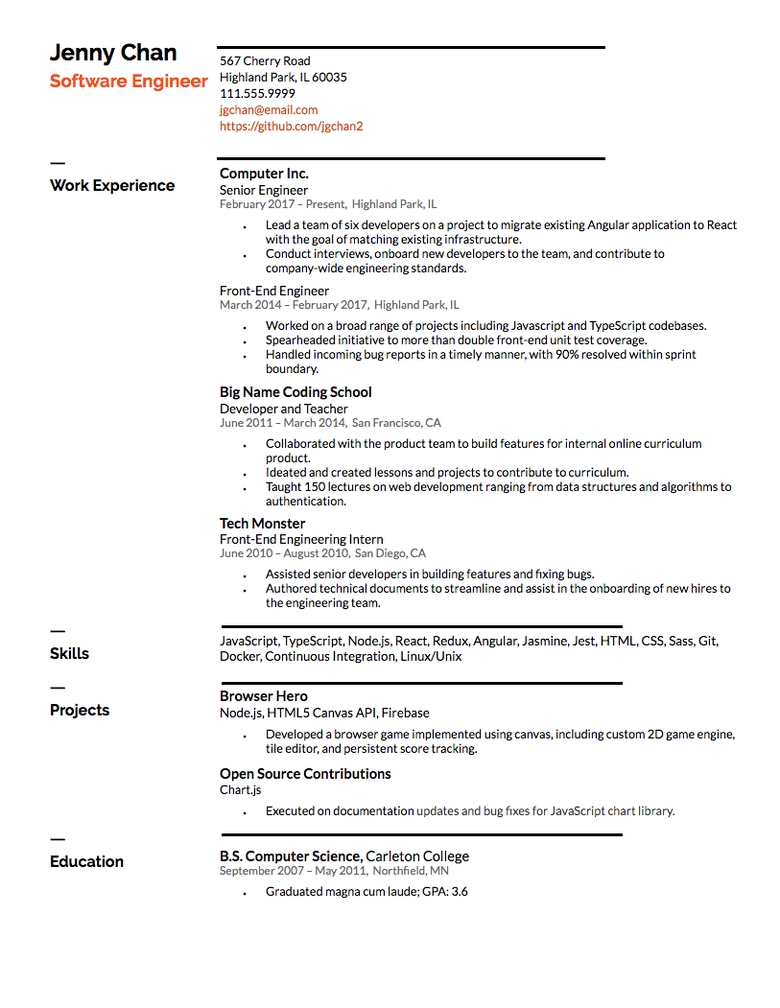
The Unorthodox Route: A Functional or Skills-Based Resume
Rather than listing out your experience in reverse chronological order, a functional or skills-based resume has bullet points that reflect how each of your skills is demonstrated by the work you’ve done over the course of your career. At the bottom, you’ll include everything else, such as your education, job history, professional achievements, community involvement, and other technical skills. This is a good option if you have a somewhat all-over-the-place work history and want to tie everything together neatly.
Who it’s good for: Career changers whose work experiences may not appear to be relevant and people with an abundance of temporary jobs or gaps in their work histories.
Download an Example Functional Resume for a Project Manager
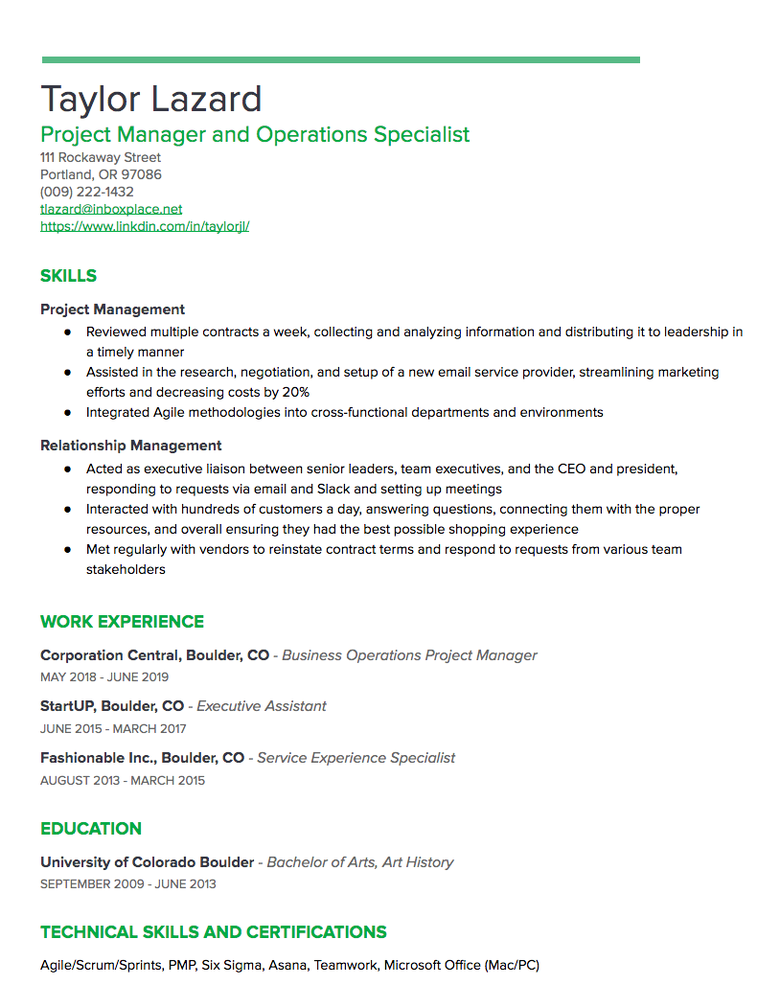
The Creative Angle: An Infographic Resume or Resume Website
This resume type is characterized by how it’s formatted visually. You may choose a reverse chronological order or skills-based style to organize your information, but also use graphics, colors, unique fonts, and even multimedia elements to help that information pop. Keep in mind that any creative resume is still likely subject to an ATS—and certain elements may be unreadable by a robot. So consider going this route only if you know a human will be reading your resume (and that said human might enjoy it).
Who it’s good for: People applying to creative roles (designers, editors, writers, marketers, video producers, for example), startups, or fun companies, or to jobs where a creative resume is encouraged, if not required.
Download an Example Infographic Resume for a Designer
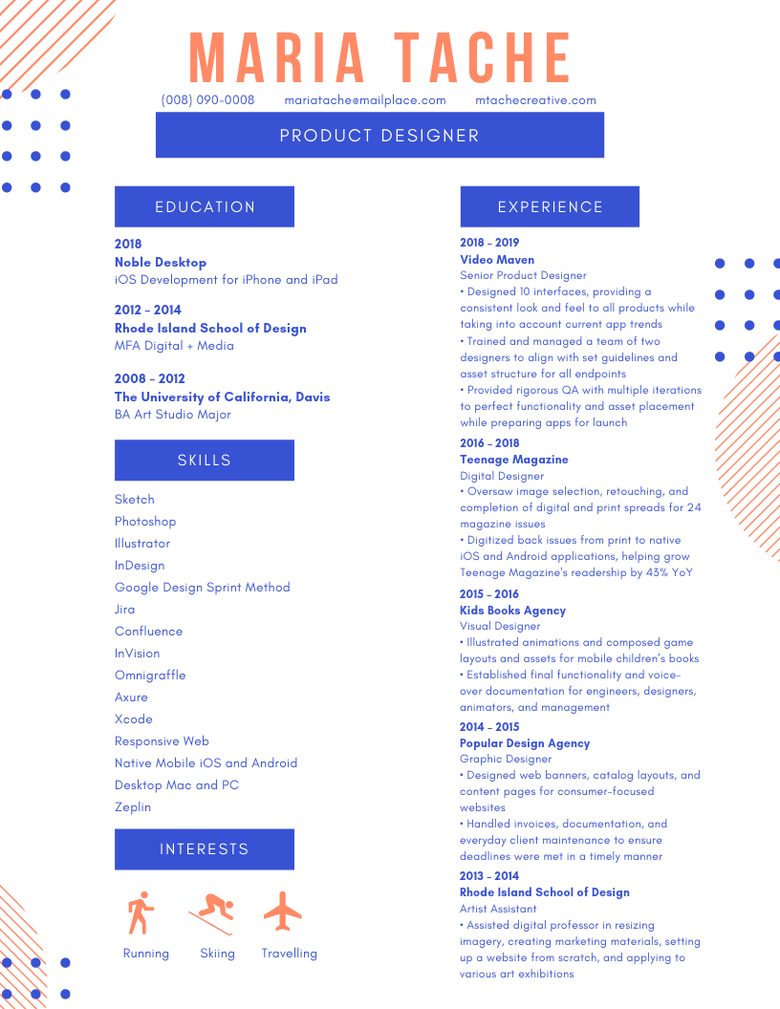
Not a designer but want your resume to look just as pretty as this example? Check out these articles:
- 5 Sites to Create an Awesome Infographic Resume (Even if You’re the Least Creative Person Ever)
- How to Build a Resume Website That Will Impress Every Hiring Manager Who Sees It
- 5 Digital Tools That Will Make Your Resume Infinitely More Beautiful
Your resume is a living, breathing document. So while you won’t go through this whole process every time you apply for a job, you should be thinking about all these things as you go to update your resume for your next career step. You might decide later on to switch up the order, or remove or add things, or even get creative and try out a whole new format. If you’re not getting the calls back you expect, you may decide to scrap it and start over —and that’s totally OK.
Regardless of where this piece of paper goes and how it grows, when you give it the care and attention it deserves, you set yourself up for success. And you’ll make it that much more likely that you’ll land an interview and get the chance to prove to the hiring manager—over the phone or in person—what you’ve got to offer.
Protect your data
This site uses cookies and related technologies for site operation, and analytics as described in our Privacy Policy . You may choose to consent to our use of these technologies, reject non-essential technologies, or further manage your preferences.
- Resume and Cover Letter
- Functional Resume: Writing...
Functional Resume: Writing Guide, Examples, & Template
11 min read · Updated on August 28, 2024

What is a functional resume, and is it suitable for your job search?
Submitting the best resume possible is essential regardless of the job you're applying to. Selecting the proper format for your unique circumstances is one aspect of ensuring that's the case. Many turn to the common chronological resume format. But what happens if your work history and skills don't fall neatly within that format? Then, a functional resume might be an option.
Below, we answer, “What is a functional resume?” and share tips with a template, as well.
What is a functional resume?
The functional resume format emphasizes your skills over your work history. The goal of a functional resume is to craft your carer history in such a way that proves how the skills you've acquired align with the job you want. It's these skills that will stand out first and foremost to the hiring team.
You still include your work history in a functional resume, though you don't go into detail about your accomplishments for each specific position. Instead, you include your accomplishments within each skill category.
FORESHADOWING: We have a functional resume example at the end of this post you can refer to and see how this works.
A functional resume tends to be a last-resort format for a couple of reasons:
Applicant tracking systems sometimes have a difficult time reading a functional resume format.
Since the functional format is not that common, it can be more difficult for recruiters and hiring managers to find the information they're seeking quickly.
Still, if you don't have a traditional work history but have many skills relevant to the job you're applying for, a functional resume could be the best choice for you.

What is a functional resume vs. a chronological resume?
The chronological resume, also referred to as a reverse chronological resume, is the most commonly used resume format. This format focuses on your work history instead of skills like the functional format.
In the chronological format, you will include your most recent job first, with the rest of your experience in reverse chronological order. Each position will have a set of bullets that flesh out your achievements in that role.
A chronological resume is an ATS-friendly format when it's written correctly. It also tends to be the most popular among hiring teams since they're familiar with the format and can easily locate the information that matters to them.
Related reading: How to Use a Reverse Chronological Resume Format
What is a functional resume vs. a hybrid resume?
A hybrid resume, also called a combination resume, blends aspects of the chronological and functional resume formats. The goal of a hybrid resume is to equally emphasize your skills and work history.
The hybrid resume has become a popular format choice for candidates since it gives the opportunity to emphasize the skills you have in combination with your work history. It's also a format that tends to be easily read by ATS and human readers.
Related reading: The Best Resume Format to Get You Hired
When should you use a functional resume?
Now that we've answered “What is a functional resume?” let's discuss when you should and shouldn't use this format option.
A functional resume might work well for you if:
You have been out of the workforce for a while. Suppose you're reentering the workforce after some time. In that case, you might not want that fact to be the first thing prospective employers notice about your resume. Instead, you'd prefer they see your impressive categories of skills.
You have a large gap in your employment history. Similar to being out of the workforce for a while, a functional resume helps to emphasize your relevant skills first to give a positive spin on your resume, helping to take the emphasis off of your employment gap(s).
You have held jobs that span a lot of different types and industries . If your employment record is all over the place regarding the industries and types of jobs you've held, it might not be easy for a hiring team to connect your experience to the job you're applying for. A functional resume will allow you to emphasize that you have the skills necessary for the job first, so your diverse employment record isn't called into question (hopefully) as much.
You have little to no work experience. You might not have much work experience if you're right out of college. You do likely, however, have a lot of skills you've acquired through school activities, sports, part-time work, or school clubs. A functional resume allows you to be creative in the skills you represent first, helping to grab the attention of hiring teams with what's most relevant.
Your skills have been acquired through means other than traditional work experience. Suppose you have relevant skills acquired through things like hobbies, interests, or volunteer experience over conventional work experience. In that case, a functional resume will allow you to emphasize these skills so they stand out better than they would in a chronological format.
When should you not use a functional resume?
If any of the following pertain to you, then it's likely in your best interest to choose a hybrid or chronological resume format:
You have a traditional employment career trajectory. If you have plenty of work experience related to the job with a typical career growth path, then a chronological or hybrid resume is the way to go.
You're changing careers and want to emphasize transferable skills. If you've gained a lot of transferable skills and are making a career shift, a hybrid resume is an excellent way to highlight your transferable skills first, with your work experience coming in second.
Your most recent employment history is relevant. If your most recent employment is relevant to the job, even if some of the rest of your work history isn't, you'll likely do better with a hybrid or chronological format over a functional one.
What to include in a functional resume
Here are the sections to include in a functional resume:
Start with your contact information
Regardless of the format you select, you'll start it off with your contact information. This includes your name, cell phone number, email address, and location (city, state, zip code). You can also include your LinkedIn or professional website URL.
Kick it off with a resume summary
Another common element across all resume formats is starting it off with a resume summary . Your summary should encapsulate what your resume is about. You want to grab the reader's attention enough for them to want to learn more. Include three to five essential skills and one to two accomplishments, with some powerful adjectives to describe you.
Categorize your skills
The bulk of your resume for a functional format will be your Professional Skills section. Here's where you'll categorize your skills and include key accomplishments from your experience to showcase how you applied those skills successfully in the past.
Incorporate your work history
Following your Professional Skills section, include your work history. Here, include the name of the employer, your position, and the dates you were employed. Where you would include bullet points of your accomplishments below each position for a chronological and hybrid format, you will leave those off in the functional format. You've already covered key accomplishments within your categories of skills.
Close it off with education
Like other resume formats, your functional resume will end with your Education section . An exception to this is if you are a new hire with little to no work experience and a few skills to highlight. In that case, you'll emphasize your education by listing it first, followed by your Skills section and then your work history.
Your Education section should include your degree and where you obtained it. You can also include any honors you might've achieved.
Many also choose to include any relevant certifications in their Education section. Or, you can opt to include a separate Certifications section if you have more than one to highlight.
Include additional sections as appropriate
You may include additional sections on your resume depending on your unique circumstances. Additional sections could include Volunteer Experience, Hobbies and Interests, Certifications, Special Projects, and Technical Skills.
Tips for writing your functional resume
Here are a few additional tips to help you craft a job-winning resume:
Tailor your resume to each job. Refer to the job description and tailor your resume to include keywords and information that aligns with your skills and experience.
Use power verbs. Begin each work accomplishment bullet point with a power verb .
Include as much quantifiable information as possible. When describing your accomplishments, include results and use data to quantify those results as much as possible.
Example of a functional resume
Here is an example of a functional resume for someone pursuing an HR-related job. You'll see this individual has a brief employment gap and a bit of an unconventional career path, making a functional resume a suitable option.
Kendra Smith
555.555.5555 | [email protected] | Morgantown, WV 26250
Intuitive professional with multi-dimensional expertise in Human Resources for diverse group of industries, including oil & gas, finance, Internet marketing, and real estate. Timely and efficient with the ability to work with all levels of staff within an organization. Influential in working with leadership teams to support the best interests and wellbeing of employees. Expertise includes recruiting, employee relations, training and development, and performance management.
PROFESSIONAL SKILLS
Staffing & Recruiting
- Partnered with recruiters to rebuild workforce after a 40% reduction due to Hurricane Katrina relocation
- Counseled management while going through a reduction in force for 150+ positions
- Recruited for over 500 positions in multi-faceted environments
- Utilized applicant tracking system (ATS) software, including Taleo, JobVite, and SAP, to monitor resume submissions and data
- Designed a one-stop shop website to assist new hires in assimilating to the community and company
Employee Relations & Performance Management
- Managed employee relations for global and domestic client groups totaling 500-700 employees for multi-million dollar companies
- Designed and implemented new company-wide Service Award Program
- Developed new Performance Management process resulting in more effective employee development, documentation, and communication
- Directed relocation project and successfully transferred 300+ positions from Austin to Houston, TX
Communications & Policy Design
- Prepared and administered 40+ HR-focused policies, including performance management, non-solicitation, harassment, education reimbursement, annual MVR reviews, and discipline for $4.5B start-up company
- Partnered with HR & Legal departments to develop and present materials for pertinent employee communications, including Austin relocation, benefits open enrollment, and policy updates
- Presented HR updates, including goals and projects, for monthly Leadership staff meetings
- Drafted and wrote 200+ employee, HR, and CEO communications
Training & Development
- Developed 30+ training modules focused on HR Foundational skills for supervisors and managers, including union avoidance, effective communication, performance management, employment law, recruiting, and employee development
- Spearheaded culturally sensitive technical and professional career development plans for 100 international and domestic employees
- Trained HR colleagues on I-9 government compliance
WORK EXPERIENCE
HR SME Copywriter: IESquared, LLC, Houston, TX, 6/2020 - Present
Public Relations Specialist: PrimeWay Credit Union, Houston, TX. 4/2017 - 6/2020
HR Recruiter: HighMount E & P, Oklahoma City, OK, 11/2012 - 5/2013
HR Operations Manager: Dominion E & P, Houston, TX, 9/2010 - 10/2012
EDUCATION
West Virginia University – Morgantown, WV
- Master of Science in Human Resources and Industrial Relations
- Bachelor of Science in Business Administration
Is a functional resume right for you?
Now that you know the answer to “What is a functional resume?” it's time to decide if it's the right option for you. If you have a traditional work history, recent relevant work, or are applying for a job where your work history is necessary to include in detail, then you should forgo the functional resume format. If you fall into any of the other categories above where a functional resume could be of value, then go for it. And, when in doubt, you can always hire a resume writer to help. Good luck!
Are you using the right format for your resume? Find out by submitting it for a free resume review . Our experts will review it and provide specific tips to help improve it and get past an ATS!
Recommended reading:
How to Check If My Resume Is ATS-Friendly for Free
15 Expert Tips to Working with Recruiters
Strategic Job Search Planning: Land Your Dream Job
Related Articles:
How to Write a Short Bio? (With Examples)
7 Best Personal Skills for Your Resume (With Examples)
Great Jobs for Teens: Top Picks for 16-Year-Olds
See how your resume stacks up.
Career Advice Newsletter
Our experts gather the best career & resume tips weekly. Delivered weekly, always free.
Thanks! Career advice is on its way.
Share this article:
Let's stay in touch.
Subscribe today to get job tips and career advice that will come in handy.
Your information is secure. Please read our privacy policy for more information.

Search form
Make a Gift
Department of Economics
- Undergraduate
18 Résumé Writing Tips to Help You Stand Out
By Allison Pohle
Updated May 11, 2021 2:15 pm ET
- A résumé isn’t just a list of every job you’ve ever had. It should demonstrate your accomplishments.
- Mirror language used in the job posting so your résumé isn’t discarded by an applicant tracking system.
- Use a clean and simple format.
Companies increasingly rely on software to sort through applicants, which is why it is essential to tailor your résumé to ensure it makes the cut. Applicant tracking systems sort, scan and rank applicants by looking for keywords in applications. Although these programs can save time and money for employers, about 60% said such tools cause them to miss some qualified candidates, according to a 2016 survey of 1,200 job seekers and managers by CareerArc, a human-resources technology company, and Future Workplace, a research firm. Here’s how to make your résumé stand out to robots and humans alike.
1. Highlight your achievements in your résumé.
A common mistake job seekers make is believing a résumé is a recap of your career, when in reality, it should convey what you have accomplished, says Christy Noel, a career expert and author of “Your Personal Career Coach.”
“I always say, spend less of your real estate describing your job, and more time describing your results,” says Ms. Noel.
2. Customize your résumé.
Read over the job posting, and think about the work experience you have had that is most directly relevant to the position you are pursuing. You can leave out some past jobs and internships if the experience you had wasn’t related. Whatever you do: Don’t submit a generic résumé to dozens of postings. “Even if you have the best experience, if your résumé isn’t speaking directly to the position in which you are applying, there is a strong chance you’ll never even get an interview,” says Demisha Jennings, a certified professional résumé writer and founder and owner of She Assists LLC.
The same applies to your cover letter. It is your chance to provide more detail on how your experience will help you succeed in the job. Read our cover letter guide for how to write one that makes you stand out.
3. Decide how to format your résumé.
Most of the time, a chronological résumé will work well for communicating your past experience. But, in some cases, a functional or hybrid résumé might be more appropriate. Read more about résumé formats here.
4. Make your contact information easy to find.
Include your name, phone number, email address, city and state. It may also be appropriate to include the URL to your LinkedIn profile. You want it to be easy for hiring managers to reach out.
In addition to making it easy to connect with you, it is important to your job search that you grow your network. Read our networking guide for tips on how to do so.
5. Consider adding a summary.
Many résumé templates leave space for an objective statement, outlining career goals, but that approach is outdated, says Ms. Jennings. Instead, consider a carefully worded summary. The summary is often the first place a hiring manager will look, and gives you an opportunity to introduce your skills high up on the page. You can also work in relevant keywords from the job description. “Recruiters are looking for what you can bring to the table and what you’ve done, rather than you saying, ‘I’m seeking a position,’” Ms. Jennings says.
6. Great résumés should stand out to skim readers.
Most recruiters spend just a few seconds skimming through a résumé—with an average in one study of 7.4 seconds.
To have the best chance of making an impression, ensure your job titles, company names and dates of employment are easy to read. The sections of your résumé should be adequately spaced, too, says Dana Leavy-Detrick, founder and director of Brooklyn Resume Studio.
For additional ways to make a good impression on recruiters and headhunters, read our guide on how to work with headhunters .
7. Make your résumé robot-friendly.
Structure your résumé to meet the requirements of an applicant tracking system to give yourself the best chance of having it reach an actual human. Ms. Leavy-Detrick suggests the following:
- Optimize keywords. Use the same words and language that are in the job description. For example, three different companies might describe the same role as “programmer,” “developer” or “software engineer.”
- Use a straightforward format. Avoid tables and text-based graphics, which might not get picked up by a scan of the résumé. Sans-serif fonts such as Arial or Helvetica are also best to ensure readability.
- Think about order. When formatting each line item of work experience, list the company name first, followed by the job location (city, state), your job title, and your start and end dates. Some résumés can get lost if the dates are listed before the job title.
8. Prioritize relevant keywords.
Tailoring your skills to include language from the job posting is an important way to let both the applicant tracking system and, eventually, a hiring manager, see how your prior qualifications tie into the job requirements. But just because you have a résumé full of keywords doesn’t mean you’ll automatically get an interview. “The ATS isn’t there to help the job seeker, it is there to help the employer review your skills against their most important qualifications,” says Ashley Watkins, a career coach and résumé writer with Write Step Résumés LLC.
9. Craft compelling and concise bullet points.
The goal of a résumé is to list your accomplishments, rather than every duty you performed in the role. Résumé-writing experts recommend including no more than five bullet points per prior job listed.
- Don’t focus on tasks. Many job seekers describe what they did every day, such as answering phones or creating marketing materials, Ms. Watkins says. “Simply copying and pasting the job description doesn’t account for the things you did great, that you did above and beyond your peers,” she says.
- Instead, explain what those tasks achieved. Emphasize your results. Ms. Watkins suggests asking yourself “Did I save [the employer] money? Did I save time? Did I improve a process? Did I build a relationship?” These will help you format your bullet points.
- Use metrics. Say what you achieved, then contextualize it—with figures if possible. You might not be able to put a monetary value on every accomplishment, but you can frame it by sharing details like the time it took or how many people were involved. “If you raised sales 50% in two months, that means a whole lot more than ‘I’m in charge of sales,’” Ms. Watkins says.
- Don’t omit accomplishments that aren’t quantifiable. Not every achievement will have metrics to show success. If there are figures, you might not always have access to them. But that shouldn’t stop you from including them, says Ms. Leavy-Detrick. Perhaps you had a positive impact on the culture of an organization, or improved a struggling relationship with a client. These efforts could help to demonstrate your soft skills.
10. Focus on transferable skills if you lack experience.
If you are applying for a job in a new field or you are an entry-level applicant and don’t have much direct experience, don’t worry. Highlight transferable skills you have developed in the past that will serve you well in the position, says Ms. Leavy-Detrick. For example, you could play up leadership skills you developed participating in an extracurricular activity or time-management skills you learned in a prior job.
11. Go beyond your work history, and include all relevant experience.
If you are new to the workforce, or are job-hunting after being laid off, you could also include related experience that was outside of a traditional full-time job, says Ms. Watkins. For example, you can highlight volunteer work, consulting projects or educational training, all as part of making the case for your unique value, she says.
12. Don’t worry too much about gaps in your résumé.
The Covid-19 pandemic economy resulted in many people being laid off or furloughed. Ms. Watkins says the 2020 job market reminds her of 2008, when she worked as a recruiter. The expectation at that time, she says, was that candidates would have gaps on their résumés or list more short-term positions. While it isn’t necessary to directly address the gaps in your résumé, you should be prepared to talk about them in an interview . “The focus should not be centered on the fact that you were furloughed or laid off, it should be focused on you and your skills and what you do that impacts the company’s bottom line in a positive way,” Ms. Watkins says.
While it is common to list the months and years you started and ended positions in the job history section, you could just use years. This will draw less attention to a six- or eight-month gap, says Ms. Leavy-Detrick.
13. Highlight relevant skills.
It is common to add a skills section to your résumé , outlining expertise relevant to the position. You can include languages you speak, technical skills or courses you have done. If you lack experience, you can also complete some trainings, which you can find on LinkedIn and elsewhere, related to the job you are applying for and add the courses in this section, says Ms. Jennings.
14. Prioritize work experience over education.
The professional experience you have had is often more relevant to the position than your education history, which is why the work experience should be listed first. In the “Education” section, you should list where you attended college, if applicable, or the highest level of education you have attained. If you graduated with honors, you can flag that, but it isn’t necessary to list your GPA.
15. If you are early on in your career, a key résumé tip is to limit it to one page.
If you are early on in your career, you should limit your résumé to one page. It is OK to start spilling onto a second page after you have eight to 10 years of experience, says Ms. Leavy-Detrick.
16. Add some color for a stylish résumé that sets you apart.
Your résumé should look clean and professional and you should keep applicant tracking systems in mind when formatting the document. But, if it is appropriate, you can add subtle accents of color in the section headings or in bars that separate sections as a way to differentiate your résumé. Ms. Leavy-Detrick doesn’t overstress the need for good design with her clients. “But it can definitely help,” she says. “When I say design, I don’t mean crazy graphic design. I mean having a polished application,” she says. “Think of it the same way you would coming dressed to an interview, it is part of your presentation, and so many people overlook this on the résumé.”
It may be appropriate to incorporate a more creative and graphic-based layout depending on the field in which you work and where you are applying. If you are applying for a position in a creative field, and you are emailing your résumé directly to a hiring manager, then it can be appropriate to use more designs, says Ms. Jennings. But if you are applying to a large company that uses an applicant tracking system or job portal, she says it is best to avoid using graphics unless you are working with a résumé writer who can help you get your resume through the system.
17. Proofread and double-check the formatting.
You may be eager to send your résumé or submit your application, but you should take the time to first check for typos and grammatical errors. You could also have a friend or family member look over it. When you are checking for errors, be sure to double-check the formatting. Sometimes the spacing can get thrown off when you save the file, so check how it looks as a saved document and, if you can, save it as a PDF before sending.
18. Make sure the saved file name includes your name.
Make less work for the hiring manager by including your full name in the file name of the résumé document.
What to read next
- How to Prepare for a Job Interview
- What Questions to Ask During a Job Interview
- Common Job Interview Questions and How to Answer Them
- How to Dress for a Job Interview
- How to Write a Thank-You Email After a Job Interview
- How to Negotiate and Counter a Job Offer
- How to Negotiate Salary for a New Job: The Do’s and Don’ts
- Severance Pay: What It Is and Why You Should Negotiate a Package Before Accepting a Job
Corrections & Amplifications Ashley Watkins is a résumé writer with Write Step Résumés LLC. An earlier version of this article incorrectly said Write Steps LLC. (Corrected on Nov. 20)
Copyright ©2024 Dow Jones & Company, Inc. All Rights Reserved. 87990cbe856818d5eddac44c7b1cdeb8
Appeared in the November 23, 2020, print edition as '11 Résumé Tips to Help You Get Noticed
Log In to Resume Trick
- Log in with Google
Forgot password?
Don’t have an account? Sign Up here
Create your free account
Please verify email. check your inbox and follow the activation link., recover your password.
Please enter your email to reset your password. You will receive letter with the password reset link.
How to Respond to a Recruiter on LinkedIn
- Aug 26, 2024
Navigating the professional landscape of LinkedIn often presents exciting opportunities, especially when a recruiter reaches out to you. This moment signifies that your skills and experiences have caught the attention of industry professionals.
Knowing how to respond to a recruiter on LinkedIn effectively can open doors to new career prospects. It can also set you apart in a competitive job market.
In this article, we'll explore the best strategies for responding to a recruiter on LinkedIn, from crafting a professional yet personable reply to leveraging the interaction to further your career ambitions .
LinkedIn is the only social media platform where people want to be advertised to. Lewis Howes

How did the recruiter find me on LinkedIn?
LinkedIn has become an indispensable tool for HRs seeking top talent. If you've ever wondered how recruiters discover your profile, here's an inside look at the strategies they use to find the candidates.
Keywords in your profile
Recruiters rely heavily on keywords to filter through a vast pool of candidates. They use specific terms related to skills , job titles , industries , and experiences .
For instance, if a recruiter is looking for a project manager with experience in "agile methodologies" and "software development", having these in your profile will make you more likely to appear in their search results.
LinkedIn Recruiter tool
The platform offers a specialized feature called LinkedIn Recruiter . This tool provides advanced search capabilities. It allows recruiters to filter candidates based on location , current or past companies , years of experience , and education .
This precision helps employers narrow down their search to the most relevant profiles.
Connections and networks
Your professional network plays a crucial role in increasing your visibility. If you share mutual connections with a recruiter or belong to the same professional groups, your profile is more likely to appear in their searches.
Engaging in LinkedIn groups related to your field can further boost your profile’s visibility.
Endorsements and recommendations
Profiles with numerous endorsements for specific skills or positive recommendations from colleagues and supervisors tend to attract more attention from recruiters. These features enhance your credibility and showcase your expertise, making your profile stand out.
Regularly posting updates , sharing articles , and engaging with content on LinkedIn can significantly increase your visibility. Active profiles are more likely to rank higher in search results.
For example, commenting on industry-related posts or sharing insights about your field can draw the attention of recruiters.
Profile optimization
Having a fully completed profile is essential. A professional photo , detailed job descriptions , a compelling summary , and a comprehensive list of skills can make a significant difference.
Crafting your response to a recruiter on LinkedIn
Below is a general structure for how to respond to LinkedIn recruiters whether you are interested in the opportunity or not.
1. Greeting
Begin your message with a polite and professional greeting. Address the recruiter by their name to personalize the message, which helps in establishing a friendly tone.
2. Expression of gratitude
Express your appreciation for the recruiter's interest in you . This shows that you respect their effort in reaching out and sets a positive tone for the conversation.
3. Mentioning your current status
Briefly state your current employment situation . Mentioning your role and company provides context and helps the HRs understand your professional background.
Indicate your openness to new opportunities to signal your potential interest or mention that you are not actively looking for a new job .
Conclude your message with a courteous sign-off . Provide your contact information , including your phone number and email address, to make it easy for the recruiter to reach you. This ensures that the conversation can continue smoothly.
Tips on how to respond to a recruiter on LinkedIn:
- Be prompt . Respond as soon as possible to show enthusiasm and interest.
- Be professional . Use a formal tone but keep it friendly.
- Acknowledge the recruiter . If the recruiter has mentioned any particular aspect of your profile or experience, reference that in your reply.
- Check for errors . Make sure there are no spelling or grammatical errors.
How to reply to a recruiter on LinkedIn when interested?
Show enthusiasm.
Clearly state your interest in the role and the company . Mention specific aspects of the job or company that excite you to make your enthusiasm more genuine.
Example: "I’m excited about the opportunity to learn more about this position. The role seems like a great match for my skills and career goals. Particularly because of [mention a specific aspect of the job or company that excites you]."
Highlight relevant skills
Briefly mention key skills or experiences that align with the job requirements. This helps the recruiter see the value you can bring to the role . Tailor this section to reflect the specific job description mentioned by the recruiter.
Example: "With my experience in [mention a relevant field or skill], I believe I could contribute effectively to [Company Name] and thrive in this role. For example, in my previous role at [Previous Company], I [mention a key achievement or responsibility]."
Suggest next steps
Indicate your availability for a conversation or interview and suggest a time frame. This makes it easy for the recruiter to schedule a follow-up and shows you’re proactive.
Example: "I would love to discuss this opportunity further. I’m available for a call at your convenience next week. Please let me know a time that works best for you."
Sample reply to a recruiter on LinkedIn:
Hi Jessica Smith,
Thank you for reaching out and considering me for the Marketing Manager position at Acme Corporation. I’m excited about the chance to learn more about this role. It aligns well with my career goals and interests, particularly the focus on innovative digital marketing strategies.
With my 5 years of experience in digital marketing, including a successful campaign that increased lead generation by 40% at GreenTech Solutions, I believe I could bring valuable insights and skills to your team. The role’s emphasis on data-driven decision-making and creative problem-solving resonates with my professional strengths.
I would love to discuss this opportunity further. I’m available for a call or meeting at your convenience this week. Please let me know a time that works best for you.
Looking forward to your response. Thank you once again for considering my profile.
Best regards,
Alex Johnson
How to respond to a recruiter on LinkedIn if not interested?
Responding to a LinkedIn recruiter when you’re not interested in the offered opportunity, but might be open to future ones, or when you're not interested at all, should be handled professionally and courteously.
Not interested but open to future opportunities
Sometimes, you might encounter a job offer that isn't the right fit for you at the moment. However, it could align with your career goals in the future.
Here’s a guide on how to reply to a LinkedIn recruiter and leave the door open:
Be honest about your current situation and why you’re not interested in the opportunity at this time. Keep the explanation brief and focused on your current career goals or commitments.
Show that you’re open to future possibilities by expressing your interest in staying connected and keeping the lines of communication open.
Propose connecting with the recruiter on LinkedIn or keeping in touch. This ensures that you remain on their radar for future roles and demonstrates your willingness to engage.
Sample thank you message to a recruiter on LinkedIn: Hi Jessica, Thank you very much for reaching out and considering me for the Product Marketing Manager position at TechVista Solutions. I’m honored to be considered. At this time, I’m focusing on a strategic role with Innovate Labs, and I feel that this particular role might not align with my immediate career objectives. However, I am very interested in staying connected and would love to hear about future opportunities that might align more closely with my career path. I’d be happy to connect with you here on LinkedIn and look forward to staying in touch. Please feel free to reach out if any other opportunities arise that you think might be a good fit. Thank you again for considering me, and I wish you the best in your search for the right candidate. Looking forward to keeping in touch! Best regards, Emily Carter
Not interested at all
When you’re not interested in the opportunity presented, your response should be respectful, clear, and positive.
Here's what to say to a recruiter on LinkedIn:
Be honest but tactful about your lack of interest. You don’t need to go into great detail; a simple statement will suffice.
It’s best not to provide negative feedback about the role, company, or recruitment process. Focus on your own situation and reasons for declining.
Show appreciation for the recruiter’s consideration to keep the interaction professional. End the message on a positive note by simply wishing them well.
Example of reply to a LinkedIn recruiter: Hi Alex, Thank you for reaching out and considering me for the Senior Data Analyst position at DataWorks Analytics. At this time, I am not looking to pursue new opportunities and feel that this position does not align with my current career goals. I appreciate your thinking of me for this role and for your interest in my background. Thank you again for reaching out. I wish you the best in finding the right candidate for this position. Best regards, Jordan Lee
FAQ on how to respond to a recruiter on LinkedIn
Responding to recruiters on LinkedIn can be a pivotal step in advancing your career.
By answering thoughtfully and professionally, you not only demonstrate your interest in the opportunities presented but also build valuable connections within your industry. Remember to be clear about your goals , express gratitude , and maintain a professional tone .
As you continue to refine your approach and build your network, you'll find that these interactions can lead to exciting career opportunities and meaningful professional relationships.

Alexandra Meyer
Editor-in-Chief at Resume Trick
Alexandra Meyer is the editor-in-chief of Resume Trick. She was behind the launch of Icecream Apps in 2014 and continues to oversee the high content standards of the company's projects. Alexandra has years of experience writing and editing articles about technology, software and online services, and human resources.
Rate this article:
Like the article spread the word, related articles.

How to Decline an Interview: Tips and Examples
Receiving an invitation to an interview is an important milestone in your job search. However ...
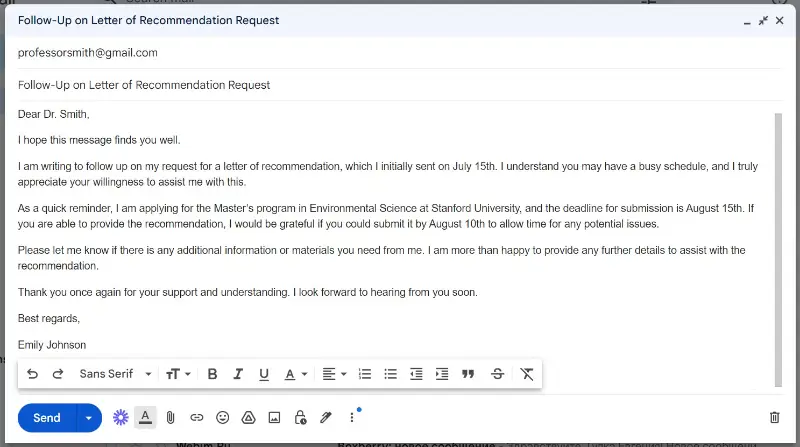
Follow Up on a Letter of Recommendation After No Response
In the competitive world of professional and academic advancement, knowing how to follow up on ...
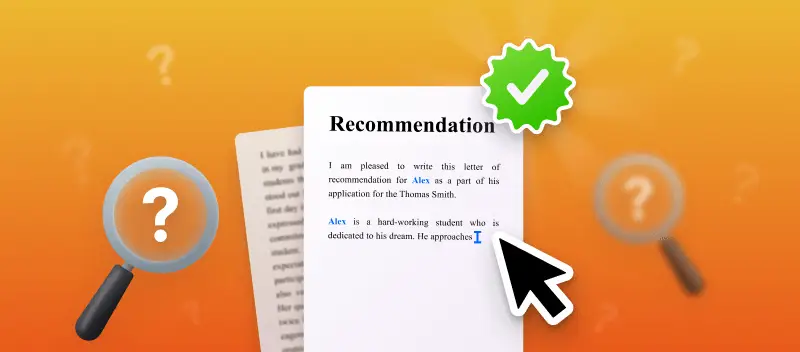
How to Write a Letter of Recommendation (with Templates)
Constructing a letter of recommendation is a big responsibility. You are given the power to ...

- Resume & Cover Letters
- HR & Workforce Management
- Finding a Job
- Career Growth
- News & Trends
The Targeted Resume: Tailoring Your Application for Specific Jobs or Companies
Find your new job.
Look for your perfect career match with the Jobillico job search!
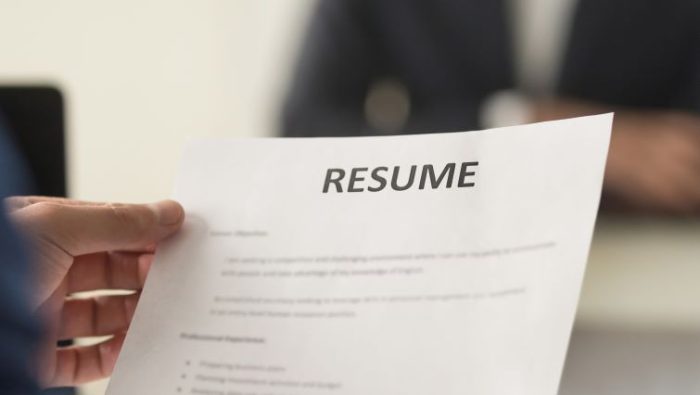
Tailor your application for specific jobs or companies by knowing how to create the targeted resume.
In today’s competitive job market , a one-size-fits-all approach to your resume won’t cut it. Employers sift through dozens, if not hundreds, of applications for every open position. It will likely be overlooked if your resume doesn’t stand out and directly address the job’s requirements. This is where a targeted resume comes into play. A targeted resume is crafted specifically for a particular job or company, showcasing your skills and experiences that align with the employer’s needs. This article will explore how to create a targeted resume, why it’s essential, and provide targeted resume examples to guide you.
Why a Targeted Resume Matters
A targeted resume is essential because it immediately highlights your suitability for a specific role. Instead of a generic resume that lists all your skills and experiences, a targeted resume zooms in on what’s most relevant to the job you’re applying for. This approach not only increases your chances of landing an interview but also helps you stand out as a candidate who has done their homework and is genuinely interested in the position.
Employers appreciate when candidates take the time to tailor their applications. It shows that you have a clear understanding of the job and the company’s needs. A targeted resume demonstrates your attention to detail and your ability to align your experiences with the employer’s expectations.
Understanding the Basics: What Is a Targeted Resume?
A targeted resume is a version of your resume that you customize for each job application . The focus is on emphasizing the experiences, skills, and qualifications that are most relevant to the specific job you’re applying for. Instead of sending out a generic resume that may not fully address the job requirements, a targeted resume zeroes in on the key attributes that make you an ideal candidate for that position.
Key Elements of a Targeted Resume
- Customized Objective or Summary Statement: Your resume should start with a clear, concise objective or summary that aligns with the job you’re applying for. This section should briefly explain how your background makes you a strong candidate for the role.
- Relevant Experience: Highlight your work experience that is most pertinent to the job. If you’re applying for a position in marketing, for example, emphasize your marketing experience and downplay unrelated roles.
- Specific Skills: Include a skills section that focuses on the abilities that are directly relevant to the job. Use keywords from the job description to ensure your resume aligns with what the employer is seeking.
- Accomplishments and Results: Showcase measurable achievements that demonstrate your ability to excel in the role. Employers want to see results, not just responsibilities.
- Tailored Education: If your educational background is particularly relevant to the job, make sure to highlight it. This is especially important for roles that require specific degrees or certifications.
How to Create a Targeted Resume
Creating a targeted resume requires a strategic approach. Here are some resume tips to help you tailor your application effectively:
1. Analyze the Job Description Start by carefully reading the job description . Highlight the key skills, experiences, and qualifications the employer is looking for. These will be the foundation of your targeted resume. Pay attention to the specific language used, as this can guide the wording you use in your resume.
For example, if the job description emphasizes project management experience, ensure that your resume includes details about your project management roles and achievements. This will make your resume more eye-catching and aligned with what the employer is seeking.
2. Match Your Skills and Experience Next, compare the job description with your skills and experience . Identify which aspects of your background align most closely with the job requirements. These are the elements you should focus on in your targeted resume.
Use targeted resume examples to see how others have successfully matched their experiences with job descriptions. By doing this, you can create a resume that speaks directly to the employer’s needs, increasing your chances of being noticed.
3. Craft a Compelling Summary Your resume’s summary or objective statement is the first thing employers will read. It needs to grab their attention and make them want to learn more about you. For a targeted resume, your summary should be specific to the job you’re applying for.
For example, instead of saying, “Experienced marketing professional seeking new opportunities,” you could say, “Results-driven marketing specialist with 5+ years of experience in digital marketing, seeking to leverage expertise in SEO and content strategy at [Company Name].”
This approach makes your resume more relevant to the job and gives the employer a clear understanding of what you bring to the table.
4. Highlight Relevant Experience When listing your work experience, focus on roles that are most relevant to the job you’re applying for. Use bullet points to outline your responsibilities and achievements, making sure to include specific examples that demonstrate your ability to perform in the role.
For instance, if the job requires experience in social media management , make sure to include details about your social media campaigns, the platforms you used, and the results you achieved. This will create a targeted resume example that shows how your past experience aligns with the job’s requirements.
Additionally, with the growing impact of AI technologies, you might consider using an AI job description generator to help tailor your resume more precisely to the job at hand. This tool can identify key terms and competencies that employers are looking for. Always be sure to review the results yourself, as hiring managers can use software and their own experience to determine if a resume has been written with AI.
5. Use Keywords Strategically Many companies use Applicant Tracking Systems ( ATS ) to filter resumes before they even reach a human recruiter. These systems scan resumes for specific keywords that match the job description. To ensure your targeted resume passes through the ATS, use the keywords from the job description in your resume. However, be careful not to overstuff your resume with keywords. The key is to use them naturally and in context. This will make your resume more effective and eye-catching while still being readable. Ensure that your resume can be easily accessed and shared, whether it’s through a WIFI network or other means, especially as more job applications and interviews shift online.
6. Include Relevant Skills In addition to your work experience, make sure to include a skills section that highlights the abilities most relevant to the job. This is especially important if the job description lists specific skills that are required or preferred.
For example, if the job requires proficiency in a particular software, make sure to include that in your skills section. This will make your targeted resume more aligned with the employer’s needs and increase your chances of being selected for an interview.
7. Tailor Your Education If your educational background is relevant to the job, make sure to highlight it in your targeted resume. This is particularly important for roles that require specific degrees or certifications.
For example, if you’re applying for a job that requires a degree in finance, make sure to include your finance degree and any relevant coursework or certifications. This will make your resume more targeted and increase your chances of being considered for the role.
Targeted Resume Examples
To better understand how to create a targeted resume, let’s look at a few targeted resume examples. These examples show how to tailor your resume for specific jobs and industries.
Example 1: Marketing Manager Position
Objective: Results-driven marketing manager with over 7 years of experience in digital marketing, seeking to leverage expertise in SEO, content strategy, and social media management to drive growth at [Company Name].
Experience:
- Developed and executed SEO strategies that increase organic traffic by 50% in one year.
- Managed social media accounts, growing followers by 30% and increasing engagement by 20%.
- Led content marketing efforts, resulting in a 15% increase in lead generation.
- SEO optimization
- Social media management
- Content strategy
Example 2: Software Engineer Position
Objective: Highly skilled software engineer with 5+ years of experience in developing and implementing complex software solutions. Seeking to contribute technical expertise to [Company Name] by building robust applications that enhance user experience.
- Designed and developed a new software application that improved workflow efficiency by 40%.
- Collaborated with cross-functional teams to implement new features based on user feedback.
- Debugged and optimized existing code, reducing load times by 25%.
- Java, Python, C++
- Agile methodology
- Full-stack development
These targeted resume examples demonstrate how to align your resume with the specific requirements of a job, increasing your chances of standing out to employers.
Common Mistakes to Avoid
While creating a targeted resume can significantly boost your job prospects, there are some common mistakes you should avoid:
- Being Too Generic A targeted resume should be specific and tailored to the job. Avoid using vague language or general statements that don’t directly address the job requirements. Instead, focus on the skills and experiences that make you the best fit for the role.
- Ignoring the Job Description The job description is your guide to creating a targeted resume. Failing to align your resume with the job description can result in your application being overlooked. Make sure to carefully read the job description and incorporate the relevant keywords and skills into your resume.
- Overloading Your Resume with Information While it’s important to include relevant information, don’t overload your resume with too much detail. Keep your resume concise and focused on the most important aspects of your experience and skills. This will make your resume more readable and eye catching to employers.
- Not Proofreading Typos and grammatical errors can make a negative impression on employers. Make sure to carefully proofread your targeted resume before submitting it. Consider asking a friend or colleague to review it as well to catch any mistakes you may have missed.
The Importance of an Eye Catching Resume
An eye-catching resume is more than just visually appealing; it’s about making sure your resume stands out from the competition. A targeted resume is naturally more eye-catching because it directly addresses the needs of the employer. By tailoring your resume to the specific job, you create a document that not only looks good but also communicates your value effectively.
In addition to the content, consider the layout and design of your resume. Use clear headings, bullet points, and consistent formatting to make your resume easy to read. Avoid using overly complex fonts or graphics that can distract from the content.
A targeted resume is your key to standing out in a crowded job market. By tailoring your resume to the specific job you’re applying for, you demonstrate your understanding of the role and your suitability for it. A well-crafted targeted resume not only increases your chances of landing an interview but also positions you as a serious contender for the job.
Remember to analyze the job description, match your skills and experience, and use keywords strategically. By avoiding common mistakes and focusing on what matters most to employers, you can create an eye catching resume that gets noticed.
As the future of AI continues to evolve, incorporating technology into your job application process can give you a competitive edge. Moreover, efficient workload management will ensure that you can tailor your applications effectively without becoming overwhelmed. So take the time to tailor your application and watch as your job search yields better results.

Rachelle Ann Raymaro
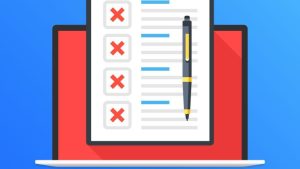
Top CV Mistakes to Avoid in 2024
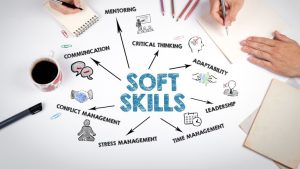
How to Showcase Soft Skills on Your Resume
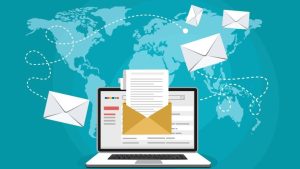
10 Resume/Cover Letter Tips for New Immigrants

How To Write A Tutor Resume – FREE TEMPLATE

How to Write an Outstanding SEO Resume (with Examples)

How To Write A Server Resume – FREE TEMPLATE
'ZDNET Recommends': What exactly does it mean?
ZDNET's recommendations are based on many hours of testing, research, and comparison shopping. We gather data from the best available sources, including vendor and retailer listings as well as other relevant and independent reviews sites. And we pore over customer reviews to find out what matters to real people who already own and use the products and services we’re assessing.
When you click through from our site to a retailer and buy a product or service, we may earn affiliate commissions. This helps support our work, but does not affect what we cover or how, and it does not affect the price you pay. Neither ZDNET nor the author are compensated for these independent reviews. Indeed, we follow strict guidelines that ensure our editorial content is never influenced by advertisers.
ZDNET's editorial team writes on behalf of you, our reader. Our goal is to deliver the most accurate information and the most knowledgeable advice possible in order to help you make smarter buying decisions on tech gear and a wide array of products and services. Our editors thoroughly review and fact-check every article to ensure that our content meets the highest standards. If we have made an error or published misleading information, we will correct or clarify the article. If you see inaccuracies in our content, please report the mistake via this form .
How to use ChatGPT to write your resume

Back-to-school season is here, which means applications to their next academic ventures, internships, or first jobs are top of mind for many students. Whether you're seeking to launch your career or you've been in the labor market for decades, there's one thing we can all agree on -- creating a resume that attracts the eye of recruiters is a challenge.
How to use ChatGPT to write: Cover letters | Code | Excel formulas | Essays
Landing a job that aligns with your qualifications and expectations is hard enough. You also have to sum up all your professional experiences and strengths in one application -- and the heart of that application is your CV or resume.
The ideal resume is a concise one-page document that highlights your academic, professional, and leadership achievements, which is just as difficult to assemble as it sounds. OpenAI's ChatGPT can make the resume-building process a breeze.
How ChatGPT can help build your resume
You can use ChatGPT to generate ideas and bullet points for your role from scratch or to refine and optimize your current points that are not hitting the mark. Beyond key points, the AI tool can help you answer questions about putting together your resume. Here's how to get started.
Side note: We are using ChatGPT, but you can use any AI chatbot -- there are plenty of capable AI chatbots to choose from .
1. Choose a resume template
ChatGPT will help you with the text in your resume, but you'll need to pick a template before you get started. The program you're using to write the resume -- such as Google Docs, Microsoft Word, or Canva -- will likely have a resume template already.
Also: How to use ChatGPT to digitize your handwritten notes for free
A quick Google search for resume templates will also bring up hundreds of editable templates you can import into your program of choice.
2. Sign in to ChatGPT (optional)
On April 1, 2024, OpenAI stopped requiring you to log in to ChatGPT. You can now access ChatGPT simply by visiting ChatGPT's website . However, if you want to take advantage of certain perks, such as being able to revisit the chat later, analyzing PDFs , or digitizing hand-written notes , you need to sign up to access those features.
Also: How to save a ChatGPT conversation to revisit later
Signing up is easy. Go to OpenAI's ChatGPT homepage and open an account by creating an OpenAI login or using your existing Google or Microsoft account. ChatGPT is free, so the sign-up process is simple, requiring no credit cards or obscure information.
3. Add text
If you want ChatGPT to generate text for your resume from scratch, all you have to do is ask.
Whether you want it to generate your professional summary or an individual bullet, ask it directly. For example, I asked ChatGPT, "Can you write a short, professional resume summary about my role as a tech reporter?" Within seconds, it generated what you see in the screenshot below.
Also: How to get ChatGPT to browse the web for free
Although ChatGPT can create content ready to be copied and pasted into a resume, you should tweak the text so it is personalized to your experiences and doesn't look like a chatbot wrote it.
Employers want to learn about what makes you unique. Without your assistance, the chatbot can only access generic content about your role. You can also use the Custom Instructions feature to share some details about your role and interests that ChatGPT can reference when outputting the text to give it a little more nuance.
4. Use ChatGPT to revamp your text
Whether you fill out the template yourself before using ChatGPT's assistance or have an existing resume you want to enhance, ChatGPT is a great resource for polishing up text.
All you have to do is copy and paste your text and ask ChatGPT to make it better.
Also: The best AI chatbots: ChatGPT and other interesting alternatives to try
For example, I asked ChatGPT, "Can you make this resume bullet sound better: 'I write stories about technology.'" Within seconds, it outputted an elaborate bullet point that incorporated a professional tone and made that simple sentence more complex, as seen in the screenshot above.
Once you get your result, you can always tell ChatGPT to tweak it further with prompts like, "Make it shorter" or "Can you include [additional details]?"
How much does it cost for ChatGPT to write my resume?
ChatGPT is currently free to use regardless of what type of writing you use it for, which includes resume-building assistance.
How can ChatGPT help me with my resume?
ChatGPT can generate text for different parts of your resume, including your professional summary and individual bullet points for each experience.
Also: How to nail the 'Do you have any questions for me?' part of the interview
The chatbot can also help enhance your current resume by optimizing your text. If you have any questions about how to format your resume and what to include, ChatGPT can give you some answers.
What should I put in my resume?
Ideally, you want a resume to highlight all your career accomplishments. This can include any educational, professional, and leadership experiences that are meaningful to you. You should also include as much detail about your unique experiences to make you stand out from other applicants.
How I test an AI chatbot's coding ability - and you can, too
How to use chatgpt: everything to know about using gpt-4o and gpt-4o mini, how to use chatgpt to analyze pdfs (and more) for free.
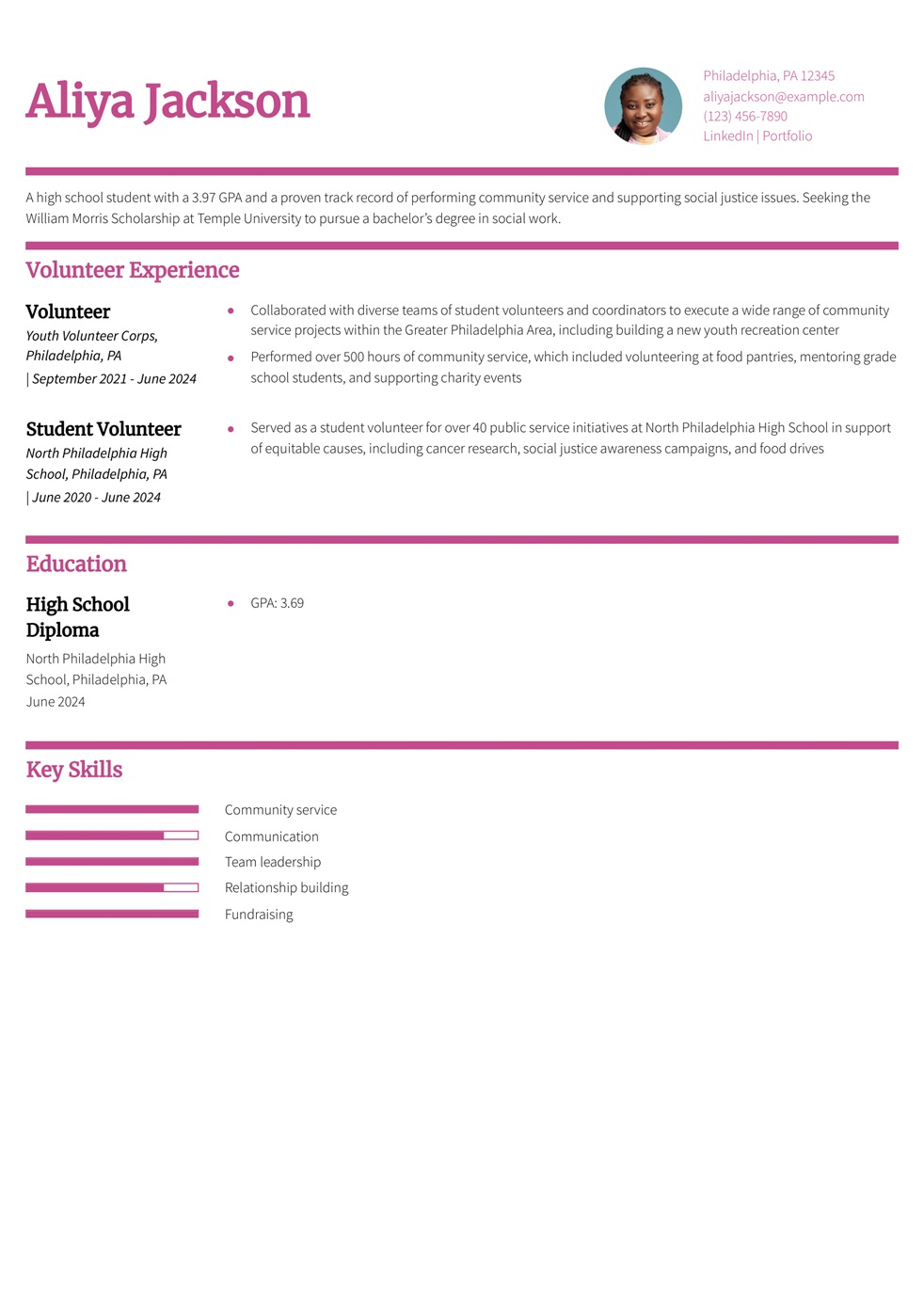
Scholarship Resume Examples and Templates for 2024

Scholarship Resume Templates and Examples (Download in App)
Most popular scholarship resumes.
- College Student
- High School Student
- Resume Text Examples
How To Write a Scholarship Resume
- Athletic Scholarship
- Student Scholarship
- College Scholarship
College Student Resume Example
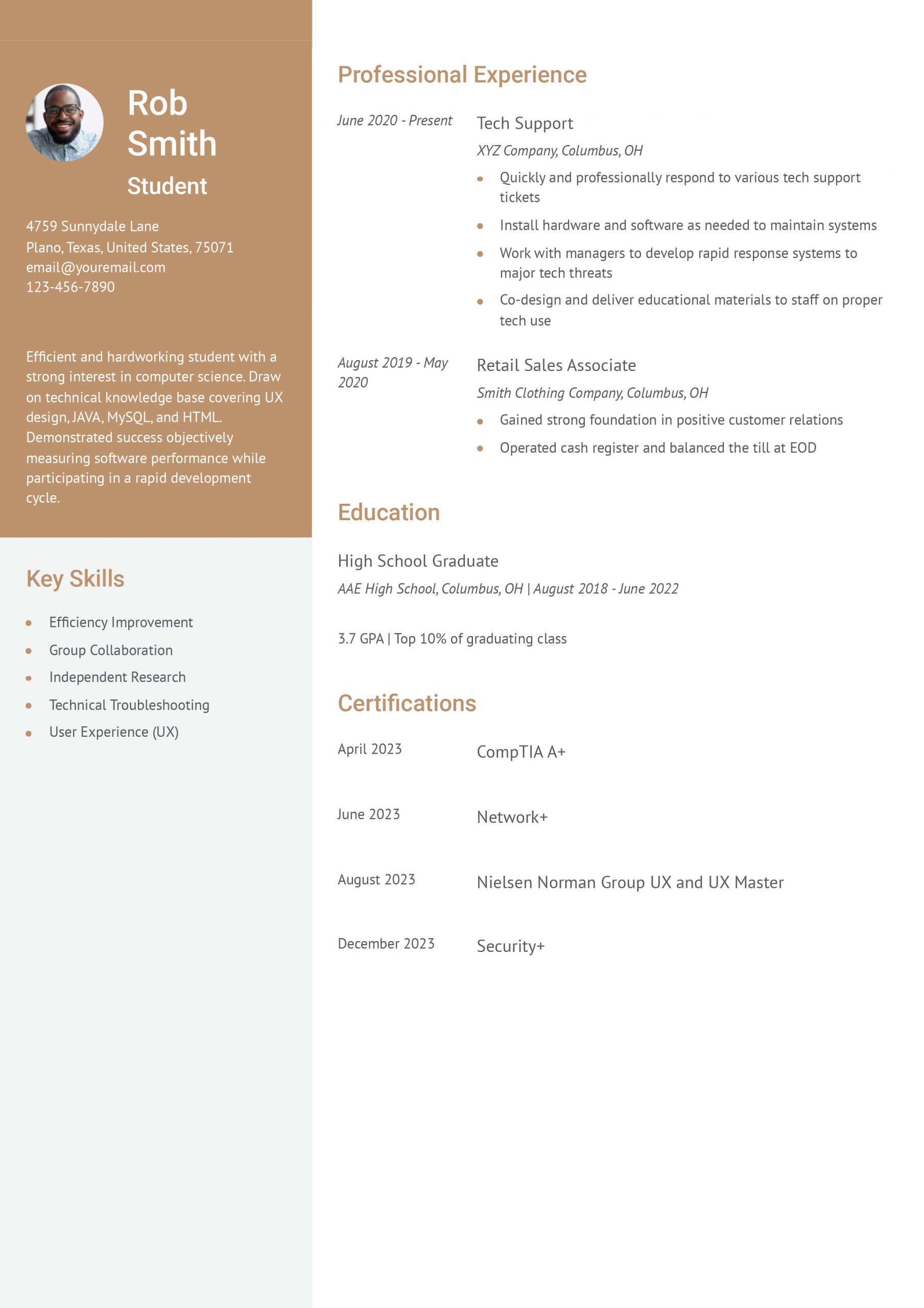
High School Student Resume Example
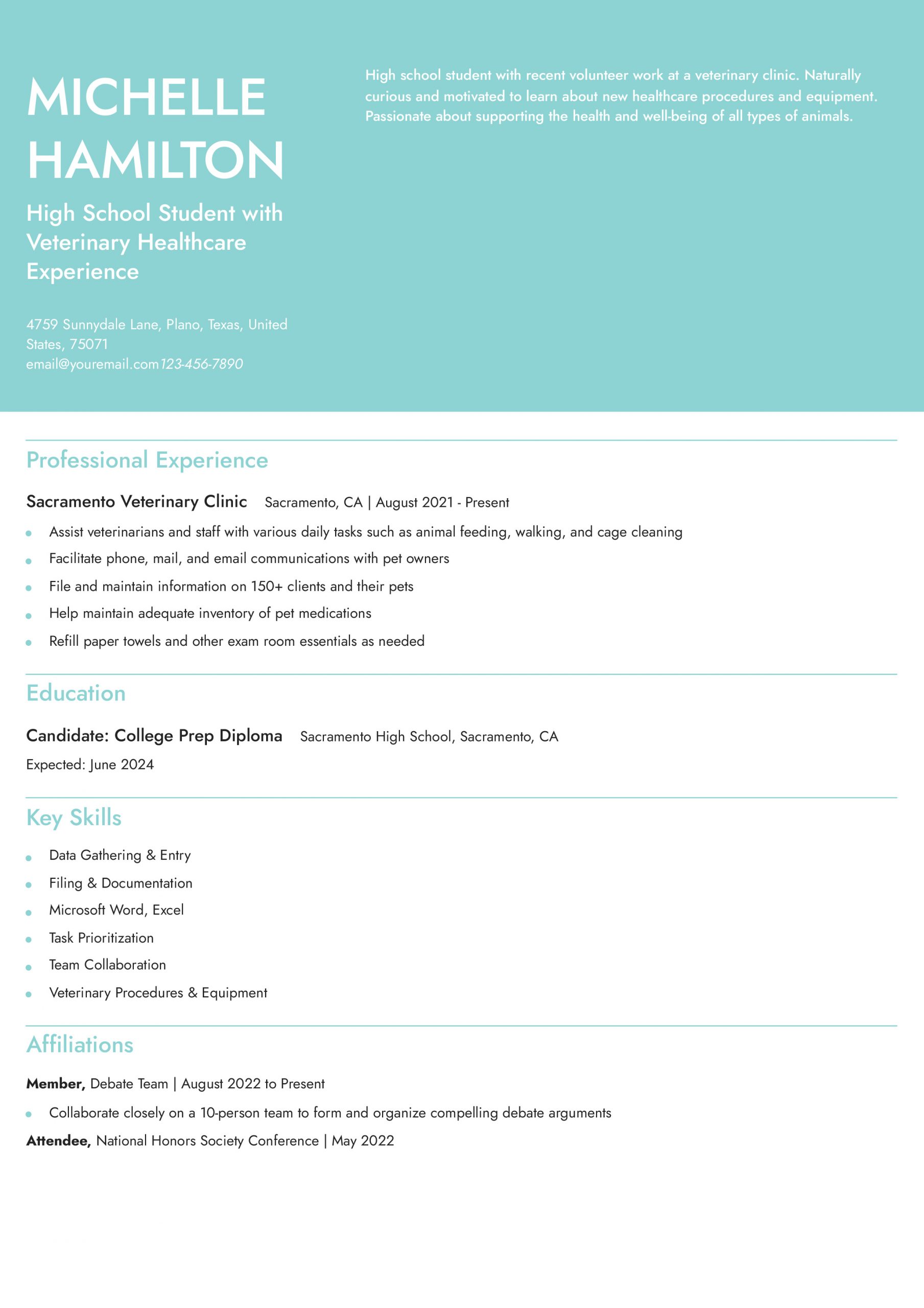
10 Student Resume Examples
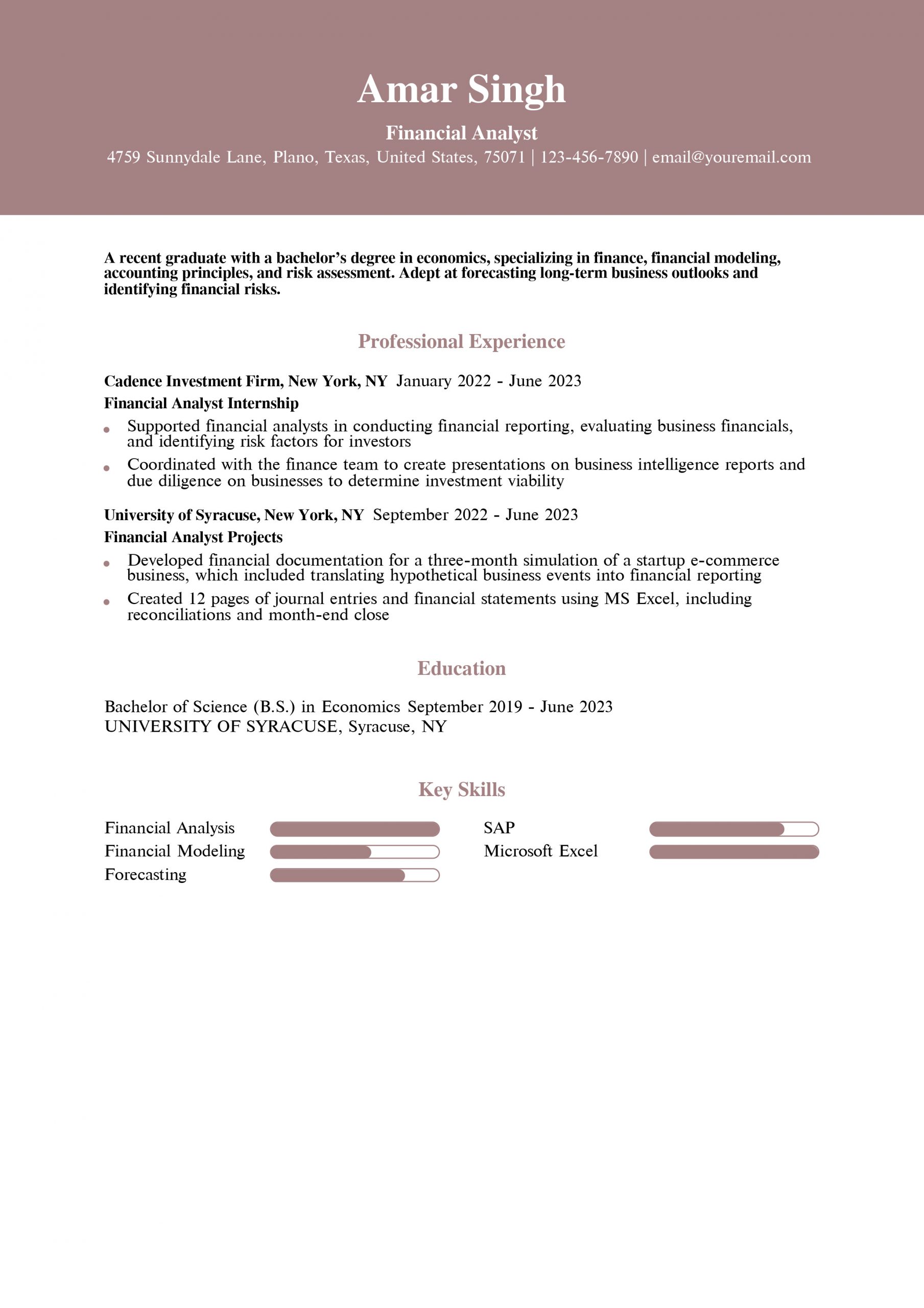
Scholarship Text-Only Resume Templates and Examples
Anthony Gentile (123) 456-7890 [email protected] Detroit, MI 12345 LinkedIn | Portfolio
An All-American student athlete with a strong history of success in high school football and basketball. A dedicated team captain with a proven track record of leading championship teams. Seeking the John Atkins Athletic Scholarship at the University of Michigan to pursue a college football career and a bachelor’s degree in philosophy.
Professional Experience
Quarterback , Ithaca High School, Ithaca, MI | August 2021 – December 2024
- Completed 229 of 315 pass attempts, achieved a 68% completion rating, and generated 3,210 passing yards, 490 rushing yards, and 37 total touchdowns during the 2024 season
- Led the Ithaca Warriors to a 13-2 regular season record and a state championship, resulting in recognition as an All-American Athlete
- Served as a team captain for the varsity football team from 2021 to 2024, which included mentoring junior athletes and increasing team morale throughout the season
Point Guard , Ithaca High School, Ithaca, MI | November 2021 – March 2022
- Acted as a team captain for the junior basketball team during the 2021 and 2022 seasons, contributing to a semi-final appearance in the state tournament
- Generated 17 points per game (PPG), 13 PPG, and five offensive rebounds PPG as a point guard
- Attended charity events with the team to raise funding for community initiatives such as food drives and Toys for Tots
- Team leadership
High School Diploma Ithaca High School, Ithaca, MI | 2024
- All-American Football Award | 2024
This scholarship resume is effective because it highlights the candidate’s athletic achievements using impactful numbers and hard data. The bullet points also convey who the applicant is as a team leader, which strengthens their overall application.
Aliya Jackson (123) 456-7890 [email protected] Philadelphia, PA 12345 LinkedIn | Portfolio
A high school student with a 3.97 GPA and a proven track record of performing community service and supporting social justice issues. Seeking the William Morris Scholarship at Temple University to pursue a bachelor’s degree in social work.
Volunteer Experience
Volunteer, Youth Volunteer Corps, Philadelphia, PA| September 2021 – June 2024
- Collaborated with diverse teams of student volunteers and coordinators to execute a wide range of community service projects within the Greater Philadelphia Area, including building a new youth recreation center
- Performed over 500 hours of community service, which included volunteering at food pantries, mentoring grade school students, and supporting charity events
Student Volunteer , North Philadelphia High School | June 2020 – June 2024
- Served as a student volunteer for over 40 public service initiatives at North Philadelphia High School in support of equitable causes, including cancer research, social justice awareness campaigns, and food drives
- Community service
- Communication
- Relationship building
- Fundraising
High School Diploma North Philadelphia High School, Philadelphia, PA | 2024
In this scholarship resume example, the applicant showcases their commitment to community service. Highlighting the number of hours they volunteered and the types of initiatives they supported helps to paint a compelling image of their background for the reader.
Hideo Araki (123) 456-7890 [email protected] Seattle, WA 12345 LinkedIn | Portfolio
A college student with a 3.96 GPA and two consecutive years on the dean’s list. A proven track record of executing innovative academic projects within the computer science field exploring AI and ML. Seeking the Morgan Technology Scholarship to continue pursuing a bachelor’s degree at the University of Washington.
Academic Experience
Computer Science Major, University of Washington, Seattle, WA| September 2022 – June 2024
- Achieved recognition as a finalist in the Technovation Competition for a project exploring novel methods for training AI using deep learning and semi-supervised learning techniques
- Executed an academic project to build a calendar management mobile application with a UX design centered on improving accessibility for senior citizens
- Achieved a 3.96 GPA over four semesters and two dean’s list awards
High School Student , Seattle Central High School | September 2018 – June 2022
- Achieved a 760 score in the Silver Division of the USA Computing Olympiad in 2022
- Maintained a 3.92 grade point average, served as a member of the National Honor Society, and led the Seattle Central High School Computer Science Club
- Software development
- Application development
- Technology innovation
Bachelor of Science (B.S.) Computer Science University of Washington, Seattle, WA | Expected 2026
- Dean’s list | 2022 – 2024
High School Diploma Seattle Central High School, Seattle, WA | 2022
- USA Computing Olympiad Silver Division | 2022
This scholarship resume is effective because it explores the candidate’s unique academic achievements within the computer science field at both the high school and college levels. The document shows that the applicant has a genuine passion for technology and has continually gone above and beyond to excel.
To write an effective scholarship resume, start by organizing your academic accomplishments, extracurriculars, and volunteer experience. Scholarship applications are evaluated based on a wide range of factors, but highlighting these aspects of your background is the best way to differentiate yourself from other candidates. Below, we’ll walk you through each step of the resume writing process.
1. Write a dynamic profile summarizing your qualifications
With the sheer number of candidates applying for scholarship programs, it’s essential to make a strong first impression on the reader. Introduce yourself and explain your academic goal. In the subsequent sentences, emphasize impressive accomplishments that demonstrate why you’re deserving of this opportunity.
For example, if you consistently achieved high grades, start by featuring your grade point average and academic awards. If you excelled in an extracurricular activity such as sports, theater, or music, display these achievements in your summary.
Strong Profile Example
A college student with a 3.96 GPA and two consecutive years on the dean’s list. A proven track record of executing innovative academic projects within the computer science field exploring artificial intelligence (AI) and machine learning (ML). Seeking the Morgan Technology Scholarship to continue pursuing a bachelor’s degree at the University of Washington.
Weak Profile Example
A college student with an excellent GPA and a strong work ethic. Passionate about computer science and academia. Seeking the Morgan Technology Scholarship.
2. Add an accomplishment-driven professional experience section
In a scholarship resume, your content needs to be centered around your most impressive academic achievements, extracurriculars, and community service contributions. It’s impossible to know the exact preferences of any individual scholarship review board, so focus on emphasizing key aspects of your high school and college career that can help you stand out from other applicants.
Strong Academic Experience Example
Computer Science Major, University of Washington, Seattle, WA | September 2022 – June 2024
- Executed an academic project to build a calendar management mobile application with a user experience (UX) design centered on improving accessibility for senior citizens
Weak Academic Experience Example
- Completed difficult computer science courses and projects on time
- Maintained a high GPA over four semesters
- Worked well with professors and fellow students in the computer science program
3. Include relevant education and academic awards
Feature your high school degree and any relevant academic awards you’ve garnered on your scholarship resume. Be sure to mention your GPA and any other academic distinctions that can bolster the strength of your application. You could also feature memberships in extracurricular clubs, organizations, or honor societies in this section.
- [Degree Name]
- [School Name], [City, State Abbreviation] | [Graduation Year]
- Bachelor of Science (B.S.) Computer Science
- University of Washington, Seattle, WA | Expected 2026
- Dean’s list | 2022 – 2024
- High School Diploma
- Seattle Central High School, Seattle, WA | 2022
4. List pertinent key skills
It’s unlikely that a university or scholarship board will be using an applicant tracking system (ATS) to identify candidates during the selection process, so you won’t need to optimize your document for keywords. That said, still provide a list of your most impressive skill sets on your scholarship resume. Below, you’ll find a range of different key skills to consider adding to your document:
| Key Skills and Proficiencies | |
|---|---|
| Biology | Communication |
| Community outreach | Computer science |
| Data analysis | English |
| Environmental science | Leadership |
| Literary analysis | Mathematics |
| Music | Physics |
| Programming | Psychology |
| Quantitative analysis | Team collaboration |
| Visual arts | |
How To Pick The Best Scholarship Resume Template
To send the right message to the scholarship board, you need a professional resume template that organizes and presents your information effectively. Avoid formats that are overly reliant on visual elements, as this might draw the reader’s eye away from your academic achievements and extracurricular activities. Opt for a straightforward template with a top-down structure that displays each section of your scholarship resume in a sequence.
Frequently Asked Questions: Scholarship Resume Examples and Advice
What are common action verbs for scholarship resumes -.
Incorporating action verbs can add a unique and engaging element to your bullet points. That said, it’s easy to use the same words repeatedly during the resume-building process. We’ve compiled a list of action verbs to diversify your language and enhance the impact of your resume content.
| Action Verbs | |
|---|---|
| Achieved | Analyzed |
| Built | Collaborated |
| Communicated | Conducted |
| Created | Designed |
| Developed | Diagnosed |
| Evaluated | Identified |
| Led | Maintained |
| Supported | Volunteered |
| Wrote | |
How do you align your resume with a scholarship description? -
Adjusting your resume to match the scholarship you’re applying for is the best way to strengthen your application. As you begin building your content, start by researching the organization and what they’re looking for in a scholarship recipient. Feature key aspects of your background that match that description.
For example, if a university values students with extensive community service experience, emphasize these projects and initiatives heavily on your scholarship resume. If an organization is primarily interested in extracurricular activities, make those the focal point of your document. By tailoring your resume to each application, you’ll maximize your odds of receiving the scholarship.
What is the best scholarship resume format? -
A combination format is generally best suited for a scholarship resume, as it’s unlikely that your work history will be a key factor in the application. This allows you to reorder your education, volunteer experience, skills, and academic achievements depending on the scholarship. A reverse chronological approach can be considered if you have an impressive internship or relevant work experience you think is valuable.
Craft your perfect resume in minutes
Get 2x more interviews with Resume Builder. Access Pro Plan features for a limited time!
Most scholarship applications will require a matching cover letter. To make a strong impression on the reader, explore unique aspects of your background that you wouldn’t normally include on a resume. For example, you could explore your cultural background and personal challenges you’ve overcome. You might also convey why you’re passionate about a particular academic field, sport, or extracurricular activity. For additional information, visit our internship cover letter guide .

Frank Hackett
Certified Professional Resume Writer (CPRW)
Frank Hackett is a professional resume writer and career consultant with over eight years of experience. As the lead editor at a boutique career consulting firm, Frank developed an innovative approach to resume writing that empowers job seekers to tell their professional stories. His approach involves creating accomplishment-driven documents that balance keyword optimization with personal branding. Frank is a Certified Professional Resume Writer (CPRW) with the Professional Association of Resume Writers and Career Coaches (PAWRCC).
Check out Related Examples

College Student Resume Examples and Templates
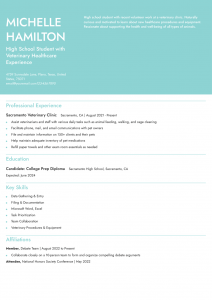
High School Student Resume Examples and Templates
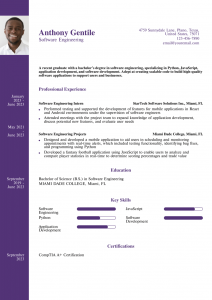
Student Resume Examples and Templates

Build a Resume to Enhance Your Career
- How To Include Extracurriculars on an Entry-Level Resume Learn More
- How To Include Personal and Academic Projects on Your Resume Learn More
- Should You Include Hobbies and Interests on Your Resume? Learn More
Essential Guides for Your Job Search
- How to Write a Resume Learn More
- How to Write a Cover Letter Learn More
- Thank You Note Examples Learn More
- Resignation Letter Examples Learn More


IMAGES
COMMENTS
Resume Design. CV/Resume Translation. $80/hr. Sahngmie L. Resume Writer. 5.0/5. (261 jobs) With a B.A. in English from Harvard and an M.A. in education from Columbia, I have both the education and the experience to take on your writing, editing, and proofreading projects.
Best Resume Writing Service For Executives: ZipJob. Best Resume Writing Service Built By Recruiters: ResumeSpice. Best Quick-Turnaround Resume Writing Service: Craft Resumes. Best Value Resume ...
So a good resume writer will make sure your resume has clean, simple formatting an ATS can read. Muse coaches, for example, typically focus "not on the fancy details, but what is going to help you get through [the ATS] and land that interview," Eonnet says. Resume formatting is also about appealing to the human reader.
United States. $59/hr. Graziana Z. Resume Writer. 4.8/5. (192 jobs) Welcome! This is your gateway to Tailored Resumes and Job Application Success. For over 7 years, I helped jobseekers outline and tailor their resumes based on their target jobs, making them stand out in today's competitive job market.
The term, "resume writing services," can refer to a wide range of editing, rewriting and/or formatting assistance that you might receive to help you create a job application submission. Using a resume writing service to help you streamline and polish your resume can be helpful at any stage in your career development, though you may need ...
Full resume rewrite. Get your resume written by a resume expert to stand out to employers. Rewritten resume + notes. 2-5 day delivery*. Get a resume rewrite for $155. "My new resume... is AWESOME! I wouldn't have been able to do this on my own." Professional upgrade - We'll rewrite and reformat your resume to align with employer preferences ...
Below, you can see a selection of the 10 best professional resume writing services, plus what they excel in: Resume Writing Services: Best Resume Writing Service. Resumeble: Best Value for Money Resume Writing Service. Monster: Best for All-in-One Service. Top Resume: Most Versatile Resume Writing Service.
Invest in your career success with comprehensive resume writing services. From crafting a compelling summary to formatting and proofreading, find a freelance resume or CV writer, and ensure your resume is polished, persuasive, and tailored to your industry.
ATS Resume Writing, Cover Letter & LinkedIn Profile Writer, CV Art & Design. 1 day delivery. From $30. Faisal M. 4.8 (295) ATS Resume/CV, Cover Letter and LinkedIn, Art & Design Resume Writing. 1 day delivery. From $35. Ussama A.
14. ResumeSpice. ResumeSpice offers a range of career services, including resume writing, cover letters, and LinkedIn profile optimization. They offer three tiered packages based on career level, with prices ranging from $479 for an entry-level resume to $699 for an executive-level resume.
4. Communication: Find a resume writer who listens to your needs and communicates throughout the process. The writer should take the time to understand your goals, accomplishments, and career history. They should also be open to feedback and willing to make revisions to ensure your satisfaction with the final product.
An entry-level resume costs $479, a professional resume costs $589 and an executive resume costs $699. In addition to these packages, you can also add a cover letter, LinkedIn profile, interview ...
What to look for. Sharon DeLay, a certified professional resume writer and career coach, was kind enough to suggest the following list of qualifications people should seek in a resume writer ...
Go to the referral's website and check them out. Start with that name and then continue your research checking on the following. · Review background, education, qualifications, credentials ...
Create Resume. Choose a resume format carefully. In 99% of cases, we recommend the reverse-chronological format. Add the right contact details. Leave your headshot out and make sure to include your job title, a professional email address, and any relevant links.
Excellent 4.9. Nakiyah B. says, "HR Impact Services, edited my resume and made it much better. It was well written with descriptions and very neatly organized. I would definitely recommend this to anyone who is seeking a job and needs help getting an interview."
5. Don't Forget Your Education. If you're still in school or just graduated, your education can go at the top of your resume, but for pretty much everyone else, this goes near the bottom. Most people include their school, graduation year (for folks less up to about a decade out of school), major, and degree.
Check the spelling of proper nouns — think: company names, addresses, etc. — and make sure you have the current contact information for any references you've chosen to add. These things might have changed since you last applied for a job. And lastly, be sure to look for common resume pitfalls before you press send.
Related: Resume samples and templates to inspire your next application. 2. Include your name and contact information. Your resume should begin with your name and contact information, including your professional email address and phone number. You have a choice about whether or not to include your mailing address.
Tips for writing your functional resume. Here are a few additional tips to help you craft a job-winning resume: Tailor your resume to each job. Refer to the job description and tailor your resume to include keywords and information that aligns with your skills and experience. Use power verbs. Begin each work accomplishment bullet point with a ...
Resume Builder offers numerous resume creation solutions for your career needs for only $2.95 during the 14-day trial period. Our application infuses AI-powered technology and writing methodologies from certified resume writers to help you build and customize your resume and cover letter. Below, you'll find our pricing options:
But just because you have a résumé full of keywords doesn't mean you'll automatically get an interview. "The ATS isn't there to help the job seeker, it is there to help the employer review your skills against their most important qualifications," says Ashley Watkins, a career coach and résumé writer with Write Step Résumés LLC. 9.
Alexandra Meyer is the editor-in-chief of Resume Trick. She was behind the launch of Icecream Apps in 2014 and continues to oversee the high content standards of the company's projects. Alexandra has years of experience writing and editing articles about technology, software and online services, and human resources.
How to create a writer resume. Here's a step-by-step guide to crafting your writer resume: 1. Provide your contact information. One of the first pieces of information a hiring manager expects to find on your resume is your contact information. This is typically written at the top of the document.
Publié le 27 August 2024 Par Rachelle Ann Raymaro. Tailor your application for specific jobs or companies by knowing how to create the targeted resume. In today's competitive job market, a one-size-fits-all approach to your resume won't cut it. Employers sift through dozens, if not hundreds, of applications for every open position.
ChatGPT will help you with the text in your resume, but you'll need to pick a template before you get started. The program you're using to write the resume -- such as Google Docs, Microsoft Word ...
Frank Hackett is a professional resume writer and career consultant with over eight years of experience. As the lead editor at a boutique career consulting firm, Frank developed an innovative approach to resume writing that empowers job seekers to tell their professional stories. His approach involves creating accomplishment-driven documents ...